-
 Two volumes, 16.6 x 11.4 cm each, uniformly bound in sprinkled calf, spine with raised bands, gilt in compartments, with crimson and black gilt lettered labels. Ink inscription to title page of vol. 1: “Thomas Fry. St: John's, Oxford.” Vol. 1: Collation: 4to; π2 ✶2 a4 b3 A-Z4 2A-2E4 2F1, (total 124 leaves), plus frontispiece, 29 in-text vignettes. Pagination: [2] – h.t., [2] – t.p., [4] – preface, [i] ii-xiv – Vie de La Fontaine, [1] 2-224, [2] – table, (total 248 pages), ils. Vol. 2: Collation: 4to; π2 ✶3 A-Z4 2A-2K4 2L3, (total 140 leavs), 40 in-text vignettes. Pagination: [2] – h.t., [2] – t.p., [6] – preface, [1] 2-268, [2] – table, (total 280 pages), ils. Illustrations: frontispiece by Lebas (signature erased), Vie de La Fontaine headpiece by Fessard after Cochin, 2 fleurons on two title pages, 69 vignettes by Chedel, Fessard, and Ravenet after Cochin (not signed). Catalogue raisonné: Lewine: 278; Cohen-deRicci: 557-8. Contributors: Charles-Nicolas Cochin (French, 1715 – 1790) – artist. Engravers: Pierre Quentin Chedel (French, 1705 – 1763). Étienne Fessard (French, 1714 – 1774). Simon François Ravenet (French, 1706 – 1764). Jacques-Philippe Le Bas [Lebas] (French, 1707 – 1783). Provenance: Thomas Fry (British, 1718 – 1772) – English priest and academic, president of St John's College, Oxford from 1757.
Two volumes, 16.6 x 11.4 cm each, uniformly bound in sprinkled calf, spine with raised bands, gilt in compartments, with crimson and black gilt lettered labels. Ink inscription to title page of vol. 1: “Thomas Fry. St: John's, Oxford.” Vol. 1: Collation: 4to; π2 ✶2 a4 b3 A-Z4 2A-2E4 2F1, (total 124 leaves), plus frontispiece, 29 in-text vignettes. Pagination: [2] – h.t., [2] – t.p., [4] – preface, [i] ii-xiv – Vie de La Fontaine, [1] 2-224, [2] – table, (total 248 pages), ils. Vol. 2: Collation: 4to; π2 ✶3 A-Z4 2A-2K4 2L3, (total 140 leavs), 40 in-text vignettes. Pagination: [2] – h.t., [2] – t.p., [6] – preface, [1] 2-268, [2] – table, (total 280 pages), ils. Illustrations: frontispiece by Lebas (signature erased), Vie de La Fontaine headpiece by Fessard after Cochin, 2 fleurons on two title pages, 69 vignettes by Chedel, Fessard, and Ravenet after Cochin (not signed). Catalogue raisonné: Lewine: 278; Cohen-deRicci: 557-8. Contributors: Charles-Nicolas Cochin (French, 1715 – 1790) – artist. Engravers: Pierre Quentin Chedel (French, 1705 – 1763). Étienne Fessard (French, 1714 – 1774). Simon François Ravenet (French, 1706 – 1764). Jacques-Philippe Le Bas [Lebas] (French, 1707 – 1783). Provenance: Thomas Fry (British, 1718 – 1772) – English priest and academic, president of St John's College, Oxford from 1757. -
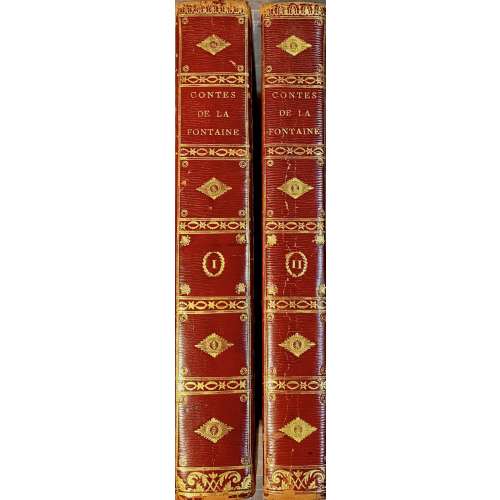 Two-volume large paper edition with 20 plates in two states. Vol. 1 (with plates). Title : CONTES | ET | NOUVELLES EN VERS. | PAR | JEAN DE LA FONTAINE. | — | TOME PREMIER| {vignette “P.P. Choffard 95”} | A PARIS, | DE L’IMPRIMERIE DE P. DIDOT L'AÎNÉ. | L’AN III DE LA RÉPUBLIQUE. | M. DCC. XCV. || Pagination: [2] [i-iv] v-vii [viii], 1-280 [2 table] [2], total 294 pages, ils. Collation: 4to; 1 blank, π4 (π3a signed “a”), 1-354 361, 1 blank, total 147 leaves, plus 40 leaves of plates with tissue guards, after Fragonard and others, which represent 20 engravings, each in two states, before and after letters, besides №9 (Le Calendrier des Vieillards by Jean Dambrun after Fragonard), which has two identical copies, both before letters. Vol. 2. (without plates) Title: same, but TOME SECOND. Pagination: [2] [4] 1-334 [2], total 342 pages. Collation: 4to; 1 blank, π2 1-414 423 1 blank, total 167 leaves. Binding: Two volumes uniformly bound in crimson straight-grain morocco, ruled in gilt, gilt-decorated flat spine with lettering, board edges and turn-ins tooled with gilt dentelles, marbled endpapers, three bookplates to front pastedown, top edge trimmed, 2nd volume partly uncut; text and plates printed on thick Dutch wove paper. Size: volumes: 33.3 x 25.2 cm; leaves: 31.5 x 23.5 cm. Provenance: Bishop, Cortlandt Field (American, 1870 – 1935) – bookplate. Mary S. Collins – bookplate by J. H. Fincken. Robin F. Satinsky (American, 1919 – 2008) – Robin Collection bookplate. Catalogue raisonné: Ray (French): 133-137; Cohen-DeRicci 573-582 ; Lewine : 281-282. CONTRIBUTORS: Jean de La Fontaine (French, 1621–1695) – author. Pierre Didot (French, 1761–1853) – publisher, printer. Artists: Jean-Honoré Fragonard (French, 1732–1806) Jean Baptiste Mallet (French, 1759–1835) Jacques Louis François Touzé (French, 1747–1807) Charles Monnet (French, 1732–after 1808) Engravers: Jacques Aliamet (French, 1726–1788) Jean Dambrun (French, 1741–about 1808) Jean Louis Delignon (French, 1755–about 1804) Jean Baptiste Michel Dupréel (French, active 1787–1817) Louis Michel Halbou (French, 1730–1809) Charles Louis Lingée (French, 1748–1819) Charles Emmanuel Jean Baptiste Patas (French, 1744–1802) Jean Baptiste Simonet (French, 1742–1813) Jean Baptiste Tilliard (French, 1740–1823) Philippe Trière (French, 1756–about 1815) Pierre-Philippe Choffard (French, 1730–1809) – t.p. vignette PLATES (collation order): №8: Fragonard / Trière – La Gageure des trois Commères №1*: Fragonard / Lingée – Joconde №1**: Mallet / Trière – Joconde №2: Fragonard / Delignon – Le Cocu battu et content №3: Fragonard / Tilliard – Le Mari confesseur №4: Fragonard / Dambrun – Le Savetier №5: Fragonard / Lingée – Le Paysan qui avait offensé son Seigneur №9: Fragonard / Dambrun – Le Calendrier des Vieillards №10: Fragonard / Aliamet – A Femme avare galant Escroc №12: Fragonard / Halbou – Le Gascon puni №11: Fragonard / Patas – On ne s’avise jamais de tout №13: Monnet / Tilliard – La Fiancée du roi de Garbe №14: Fragonard / Dupréel – La Coupe enchantée №15: Fragonard / Tilliard – Le Faucon №17: Fragonard / Patas – Le Pâté d’Anguilles №18: Fragonard / Tilliard – Le Magnifique №19: Fragonard / Delignon – La Matrone d’Ephèse №20: Fragonard / Patas – Belphégor №22: Touzé / Simonet – Le Glouton №26: Touzé / Lingée – Le Baiser rendu
Two-volume large paper edition with 20 plates in two states. Vol. 1 (with plates). Title : CONTES | ET | NOUVELLES EN VERS. | PAR | JEAN DE LA FONTAINE. | — | TOME PREMIER| {vignette “P.P. Choffard 95”} | A PARIS, | DE L’IMPRIMERIE DE P. DIDOT L'AÎNÉ. | L’AN III DE LA RÉPUBLIQUE. | M. DCC. XCV. || Pagination: [2] [i-iv] v-vii [viii], 1-280 [2 table] [2], total 294 pages, ils. Collation: 4to; 1 blank, π4 (π3a signed “a”), 1-354 361, 1 blank, total 147 leaves, plus 40 leaves of plates with tissue guards, after Fragonard and others, which represent 20 engravings, each in two states, before and after letters, besides №9 (Le Calendrier des Vieillards by Jean Dambrun after Fragonard), which has two identical copies, both before letters. Vol. 2. (without plates) Title: same, but TOME SECOND. Pagination: [2] [4] 1-334 [2], total 342 pages. Collation: 4to; 1 blank, π2 1-414 423 1 blank, total 167 leaves. Binding: Two volumes uniformly bound in crimson straight-grain morocco, ruled in gilt, gilt-decorated flat spine with lettering, board edges and turn-ins tooled with gilt dentelles, marbled endpapers, three bookplates to front pastedown, top edge trimmed, 2nd volume partly uncut; text and plates printed on thick Dutch wove paper. Size: volumes: 33.3 x 25.2 cm; leaves: 31.5 x 23.5 cm. Provenance: Bishop, Cortlandt Field (American, 1870 – 1935) – bookplate. Mary S. Collins – bookplate by J. H. Fincken. Robin F. Satinsky (American, 1919 – 2008) – Robin Collection bookplate. Catalogue raisonné: Ray (French): 133-137; Cohen-DeRicci 573-582 ; Lewine : 281-282. CONTRIBUTORS: Jean de La Fontaine (French, 1621–1695) – author. Pierre Didot (French, 1761–1853) – publisher, printer. Artists: Jean-Honoré Fragonard (French, 1732–1806) Jean Baptiste Mallet (French, 1759–1835) Jacques Louis François Touzé (French, 1747–1807) Charles Monnet (French, 1732–after 1808) Engravers: Jacques Aliamet (French, 1726–1788) Jean Dambrun (French, 1741–about 1808) Jean Louis Delignon (French, 1755–about 1804) Jean Baptiste Michel Dupréel (French, active 1787–1817) Louis Michel Halbou (French, 1730–1809) Charles Louis Lingée (French, 1748–1819) Charles Emmanuel Jean Baptiste Patas (French, 1744–1802) Jean Baptiste Simonet (French, 1742–1813) Jean Baptiste Tilliard (French, 1740–1823) Philippe Trière (French, 1756–about 1815) Pierre-Philippe Choffard (French, 1730–1809) – t.p. vignette PLATES (collation order): №8: Fragonard / Trière – La Gageure des trois Commères №1*: Fragonard / Lingée – Joconde №1**: Mallet / Trière – Joconde №2: Fragonard / Delignon – Le Cocu battu et content №3: Fragonard / Tilliard – Le Mari confesseur №4: Fragonard / Dambrun – Le Savetier №5: Fragonard / Lingée – Le Paysan qui avait offensé son Seigneur №9: Fragonard / Dambrun – Le Calendrier des Vieillards №10: Fragonard / Aliamet – A Femme avare galant Escroc №12: Fragonard / Halbou – Le Gascon puni №11: Fragonard / Patas – On ne s’avise jamais de tout №13: Monnet / Tilliard – La Fiancée du roi de Garbe №14: Fragonard / Dupréel – La Coupe enchantée №15: Fragonard / Tilliard – Le Faucon №17: Fragonard / Patas – Le Pâté d’Anguilles №18: Fragonard / Tilliard – Le Magnifique №19: Fragonard / Delignon – La Matrone d’Ephèse №20: Fragonard / Patas – Belphégor №22: Touzé / Simonet – Le Glouton №26: Touzé / Lingée – Le Baiser rendu -
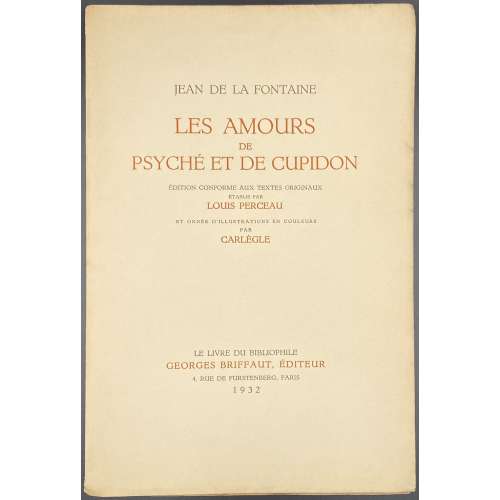 Softcover, 242 x 165 mm, French flapped wrappers with black and red lettering to front and spine, top edge trimmed, pages uncut, printed on wove paper watermarked BFK Rives in italic script; illustrations in colour. Title: JEAN DE LA FONTAINE | LES AMOURS | DE | PSYCHÉ ET DE CUPIDON | ÉDITION CONFORME AUX TEXTES ORIGINAUX | ÉTABLIE PAR | LOUIS PERCEAU | ET ORNÉE D’ILLUSTRATIONS EN COULEURS | PAR | CARLÈGLE | LE LIVRE DU BIBLIOPHILE | GEORGES BRIFFAUT, ÉDITEUR | 4, RUE DE FURSTENBERG, PARIS | 1932 || Limited edition: 1230 copies of which this ic copy № 247. Collated 8vo: π4 1-24 3-48 58 *58 6-168 χ2, total 134 leaves, incl. frontispiece. Pagination: [8] 1-253 [254] [6]. Colophon: Le volume des Amours de Psyché et de Cupidon de La Fontaine a été achevé d'imprimer le quinze juin mil neuf cent trente-deux sur les presses du maitre imprimeur Coulouma, a Argenteul, H. Barthélemy étant directeur. Coloris de E. Charpentier, Paris.
Softcover, 242 x 165 mm, French flapped wrappers with black and red lettering to front and spine, top edge trimmed, pages uncut, printed on wove paper watermarked BFK Rives in italic script; illustrations in colour. Title: JEAN DE LA FONTAINE | LES AMOURS | DE | PSYCHÉ ET DE CUPIDON | ÉDITION CONFORME AUX TEXTES ORIGINAUX | ÉTABLIE PAR | LOUIS PERCEAU | ET ORNÉE D’ILLUSTRATIONS EN COULEURS | PAR | CARLÈGLE | LE LIVRE DU BIBLIOPHILE | GEORGES BRIFFAUT, ÉDITEUR | 4, RUE DE FURSTENBERG, PARIS | 1932 || Limited edition: 1230 copies of which this ic copy № 247. Collated 8vo: π4 1-24 3-48 58 *58 6-168 χ2, total 134 leaves, incl. frontispiece. Pagination: [8] 1-253 [254] [6]. Colophon: Le volume des Amours de Psyché et de Cupidon de La Fontaine a été achevé d'imprimer le quinze juin mil neuf cent trente-deux sur les presses du maitre imprimeur Coulouma, a Argenteul, H. Barthélemy étant directeur. Coloris de E. Charpentier, Paris. -
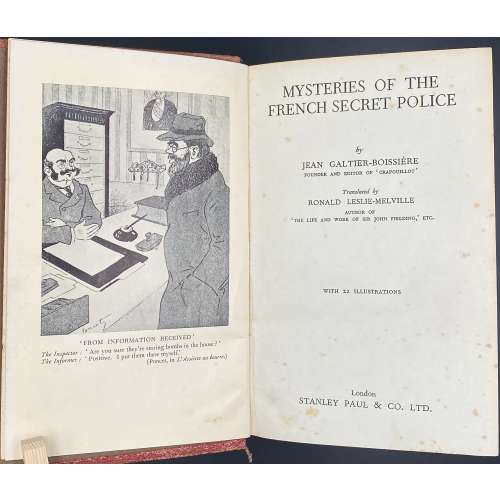 Title page: MYSTERIES OF THE | FRENCH SECRET POLICE | by | JEAN GALTIER-BOISSIÈRE | FOUNDER AND EDITOR OF ‘CRAPOUILLOT’ | Translated by | RONALD LESLIE-MELVILLE | AUTHOR OF | ‘THE LIFE AND WORK OF SIR JOHN FIELDING’, ETC. | WITH 22 ILLUSTRATIONS | London | STANLEY PAUL & CO. LTD. || Pagination: [1-8] 9-292 [16 advert], frontis., 14 pp of ill. Collation: 8vo; [A]8 B-R8 S10 + 8 leaves of advertisement + frontispiece and 7 leaves of b/w photomechanical illustrations. Binding: Burgundy cloth, gilt lettering to spine, brown endpapers. Contributors: Galtier-Boissière, Jean (French, 1891 – 1966) – author. Leslie-Melville, Ronald (British, 1905 – 1942) – translator. Stanley Paul (London) – publisher. Mayflower Press (Plymouth), William Brendon & Son (Plymouth) – printers.
Title page: MYSTERIES OF THE | FRENCH SECRET POLICE | by | JEAN GALTIER-BOISSIÈRE | FOUNDER AND EDITOR OF ‘CRAPOUILLOT’ | Translated by | RONALD LESLIE-MELVILLE | AUTHOR OF | ‘THE LIFE AND WORK OF SIR JOHN FIELDING’, ETC. | WITH 22 ILLUSTRATIONS | London | STANLEY PAUL & CO. LTD. || Pagination: [1-8] 9-292 [16 advert], frontis., 14 pp of ill. Collation: 8vo; [A]8 B-R8 S10 + 8 leaves of advertisement + frontispiece and 7 leaves of b/w photomechanical illustrations. Binding: Burgundy cloth, gilt lettering to spine, brown endpapers. Contributors: Galtier-Boissière, Jean (French, 1891 – 1966) – author. Leslie-Melville, Ronald (British, 1905 – 1942) – translator. Stanley Paul (London) – publisher. Mayflower Press (Plymouth), William Brendon & Son (Plymouth) – printers. -
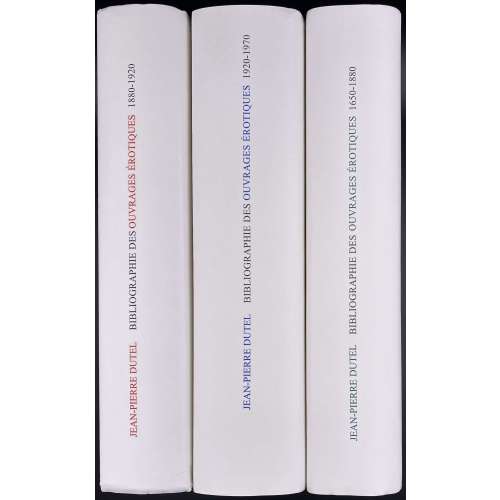 LIB-2734-1.2021. Vol. 1, title in black, DJ in black and red: JEAN-PIERRE DUTEL | BIBLIOGRAPHIE | DES | OUVRAGES ÉROTIQUES | PUBLIÉS CLANDESTINEMENT EN FRANÇAIS | ENTRE 1880 ET 1920 | {publisher’s device} | CHEZ L’AUTEUR, | 16, RUE JACQUES-CALLOT 75006 PARIS | MMII || Pagination: [1-6] 7-669 [670] [8] [2 imprint/blank]; №2046. LIB-2734-2.2021. Vol. 2, title in black, DJ in black and blue: JEAN-PIERRE DUTEL | BIBLIOGRAPHIE | DES | OUVRAGES ÉROTIQUES | PUBLIÉS CLANDESTINEMENT EN FRANÇAIS | ENTRE 1920 ET 1970 | VOLUME II | {publisher’s device} | J-P DUTEL, LIBRAIRE-ÉDITEUR | 16, RUE JACQUES-CALLOT 75006 PARIS | MMV || Pagination: [1-8] 9-891 [2 acknowl./blank] [2 imprint/blank]; №4281. LIB-2734-3.2021. Vol. 3, title in black, DJ in black and green: JEAN-PIERRE DUTEL | BIBLIOGRAPHIE | DES | OUVRAGES ÉROTIQUES | PUBLIÉS CLANDESTINEMENT EN FRANÇAIS | ENTRE 1650 ET 1880 | (VOLUME III) | {publisher’s device} | CHEZ L’AUTEUR | 16, RUE JACQUES-CALLOT 75006 PARIS | MMIX || Pagination: [1-6] 7-667 [668 blank] [2 table/blank] [2 imprint/blank]; №5726. All three volumes uniformly bound in black cloth, white DJ with lettering; vol. 1 with author’s manuscript to half-title, vol. 2 and 3 – fac-similé to title page (autographed copy).
LIB-2734-1.2021. Vol. 1, title in black, DJ in black and red: JEAN-PIERRE DUTEL | BIBLIOGRAPHIE | DES | OUVRAGES ÉROTIQUES | PUBLIÉS CLANDESTINEMENT EN FRANÇAIS | ENTRE 1880 ET 1920 | {publisher’s device} | CHEZ L’AUTEUR, | 16, RUE JACQUES-CALLOT 75006 PARIS | MMII || Pagination: [1-6] 7-669 [670] [8] [2 imprint/blank]; №2046. LIB-2734-2.2021. Vol. 2, title in black, DJ in black and blue: JEAN-PIERRE DUTEL | BIBLIOGRAPHIE | DES | OUVRAGES ÉROTIQUES | PUBLIÉS CLANDESTINEMENT EN FRANÇAIS | ENTRE 1920 ET 1970 | VOLUME II | {publisher’s device} | J-P DUTEL, LIBRAIRE-ÉDITEUR | 16, RUE JACQUES-CALLOT 75006 PARIS | MMV || Pagination: [1-8] 9-891 [2 acknowl./blank] [2 imprint/blank]; №4281. LIB-2734-3.2021. Vol. 3, title in black, DJ in black and green: JEAN-PIERRE DUTEL | BIBLIOGRAPHIE | DES | OUVRAGES ÉROTIQUES | PUBLIÉS CLANDESTINEMENT EN FRANÇAIS | ENTRE 1650 ET 1880 | (VOLUME III) | {publisher’s device} | CHEZ L’AUTEUR | 16, RUE JACQUES-CALLOT 75006 PARIS | MMIX || Pagination: [1-6] 7-667 [668 blank] [2 table/blank] [2 imprint/blank]; №5726. All three volumes uniformly bound in black cloth, white DJ with lettering; vol. 1 with author’s manuscript to half-title, vol. 2 and 3 – fac-similé to title page (autographed copy). -
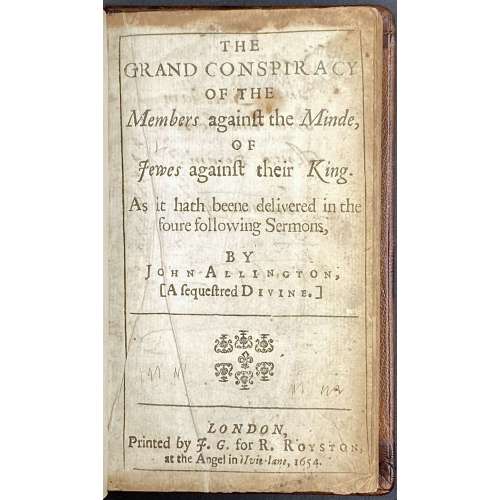 Title: THE | GRAND CONSPIRACY | OF THE | Members again∫t the Minde, | OF | Jewes again∫t their King. | As it hath beene delivered in the | foure following Sermons, | BY | John Allington, [A ∫eque∫tered Divine.] | — | {ornament} | — | LONDON, | Printed by J.G. for R. Royston, | at the Angel in Ivie-lane, 1654.|| Contents: Grand conspiracy of Jewes against their King. A sermon preached in August 1647; Grand conspiracy of Jewes against their King. A sermon preached in January 1649; Grand conspiracy of Jewes against their King. A demonstration of the highest insolencies proceed from men of the lowest and most base extractions Pagination: [2] – t.p. / blank; 1-214. Collation: 12mo; A-I12. Binding: Hardcover; 15 x 9.5 cm, later blind-stamped morocco, raised bands, gilt lettering in compartments. Inscription: Ink by hand by John Bartham, January 30, 1665, to t.p. verso; Pencil by hand to front pastedown: Wing A 1209A.
Title: THE | GRAND CONSPIRACY | OF THE | Members again∫t the Minde, | OF | Jewes again∫t their King. | As it hath beene delivered in the | foure following Sermons, | BY | John Allington, [A ∫eque∫tered Divine.] | — | {ornament} | — | LONDON, | Printed by J.G. for R. Royston, | at the Angel in Ivie-lane, 1654.|| Contents: Grand conspiracy of Jewes against their King. A sermon preached in August 1647; Grand conspiracy of Jewes against their King. A sermon preached in January 1649; Grand conspiracy of Jewes against their King. A demonstration of the highest insolencies proceed from men of the lowest and most base extractions Pagination: [2] – t.p. / blank; 1-214. Collation: 12mo; A-I12. Binding: Hardcover; 15 x 9.5 cm, later blind-stamped morocco, raised bands, gilt lettering in compartments. Inscription: Ink by hand by John Bartham, January 30, 1665, to t.p. verso; Pencil by hand to front pastedown: Wing A 1209A. -
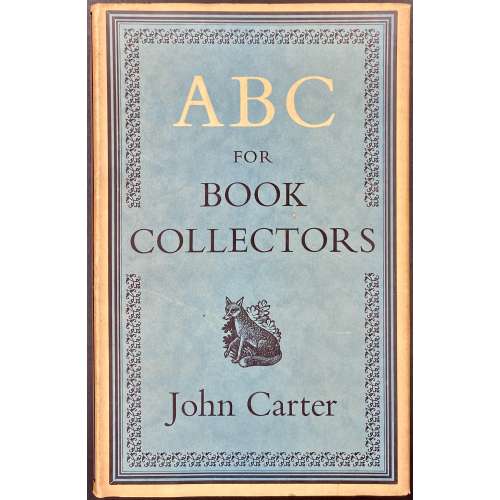 Title: ABC | FOR | BOOK-COLLECTORS | BY | JOHN CARTER | {publisher’s device} | RUPERT HART-DAVIS | SOHO SQUARE LONDON | 1952 | [TITLE-PAGE] || Pagination: [1-6] 7-191 [192 advert.], total number of pages 192. Collation: 8vo; [A]8 B-M8, total number of leaves 96. Binding: 21 x 13.5 cm, aubergine cloth, gilt lettering to spine, pictorial endpapers; cream unclipped (15s. net) dust-jacket with the sea-green panel in a border, with a fleuron frame, black and cream lettering, and publisher’s device to front; lettering to spine and back; folded prospectus insert loose. Edition: 1st. Contributors: Carter, John Waynflete (British, 1905 – 1975) – author Hart-Davis, Sir Rupert Charles (British, 1907 – 1999); Rupert Hart-Davis Ltd. (London) – publisher. Hazell, Watson and Viney, Ltd. – printer.
Title: ABC | FOR | BOOK-COLLECTORS | BY | JOHN CARTER | {publisher’s device} | RUPERT HART-DAVIS | SOHO SQUARE LONDON | 1952 | [TITLE-PAGE] || Pagination: [1-6] 7-191 [192 advert.], total number of pages 192. Collation: 8vo; [A]8 B-M8, total number of leaves 96. Binding: 21 x 13.5 cm, aubergine cloth, gilt lettering to spine, pictorial endpapers; cream unclipped (15s. net) dust-jacket with the sea-green panel in a border, with a fleuron frame, black and cream lettering, and publisher’s device to front; lettering to spine and back; folded prospectus insert loose. Edition: 1st. Contributors: Carter, John Waynflete (British, 1905 – 1975) – author Hart-Davis, Sir Rupert Charles (British, 1907 – 1999); Rupert Hart-Davis Ltd. (London) – publisher. Hazell, Watson and Viney, Ltd. – printer. -
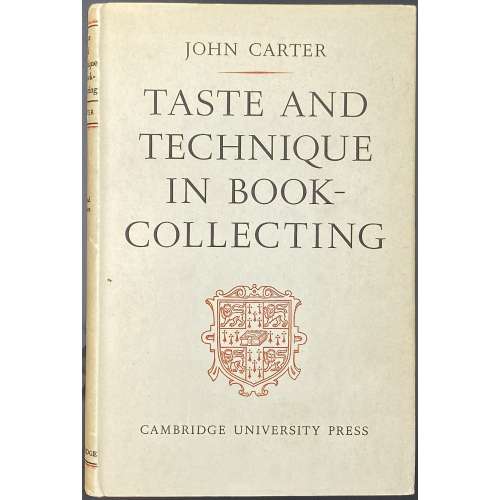 Title: TASTE & TECHNIQUE | IN | BOOK-COLLECTING | A study of recent developments in | Great Britain and the | United States | BY | JOHN CARTER | SANDERS READER IN BIBLIOGRAPHY | AND SOMETIME SCHOLAR OF | KING’S COLLEGE | {space} | {publisher’s device} | CAMBRIDGE | AT THE UNIVERSITY PRESS | 1949 || Half-title: TASTE & TECHNIQUE | IN | BOOK-COLLECTING | The Sanders Lectures in Bibliography | 1947 || Pagination: [i-vi] vii-x [xi] [xii blank], 1-201 [202 blank] [2] – advert. / blank, total 12+202+2=216 pages. Collation: 8vo; π6 1-128, 136, total 108 leaves. Binding: 22.5 x 15 cm, red cloth, gilt lettering to spine, lettered dust-jacket with armorial publisher’s device in red, price-clipped. Edition: 1st edition (1948), 2nd impression, corrected (1949). Contributors: Carter, John Waynflete (British, 1905 – 1975) – author. Cambridge University Press (Cambridge) – publisher. Brooke Crutchley – printer.
Title: TASTE & TECHNIQUE | IN | BOOK-COLLECTING | A study of recent developments in | Great Britain and the | United States | BY | JOHN CARTER | SANDERS READER IN BIBLIOGRAPHY | AND SOMETIME SCHOLAR OF | KING’S COLLEGE | {space} | {publisher’s device} | CAMBRIDGE | AT THE UNIVERSITY PRESS | 1949 || Half-title: TASTE & TECHNIQUE | IN | BOOK-COLLECTING | The Sanders Lectures in Bibliography | 1947 || Pagination: [i-vi] vii-x [xi] [xii blank], 1-201 [202 blank] [2] – advert. / blank, total 12+202+2=216 pages. Collation: 8vo; π6 1-128, 136, total 108 leaves. Binding: 22.5 x 15 cm, red cloth, gilt lettering to spine, lettered dust-jacket with armorial publisher’s device in red, price-clipped. Edition: 1st edition (1948), 2nd impression, corrected (1949). Contributors: Carter, John Waynflete (British, 1905 – 1975) – author. Cambridge University Press (Cambridge) – publisher. Brooke Crutchley – printer. -
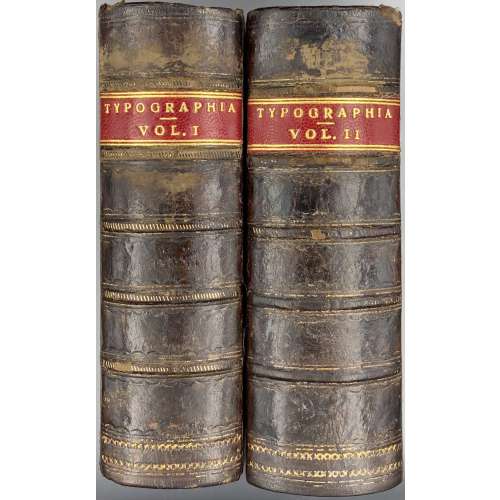 2 volume set. Vol. 1. Title: Typographia, | OR THE | Printers' Instructor : | INCLUDING AN ACCOUNT | of the | ORIGIN OF PRINTING, | with | Biographical Notices of the Printers of | England, from Caxton to the close | of the Sixteenth Century : | A Series of | Ancient and Modern Alphabets, | and | DOMESDAY CHARACTERS : | Together with | An Elucidation of every Subject con- | nected with the Art. | By J. JOHNSON, Printer. |{stanza}| Vol. I. | In frame: Published by Messrs. Longman, Hurst, | Rees, Orme, Brown & Green, Pater- | noster Row, London | Under the frame: 1824. || Typographical frame with the names of distinguished printers; on the cornerstone: William Caxton, 1474. Pagination: ffl / blank, blank / engraved frontis., engraved t.p. / blank, engraved dedication / list of club members, engraved arms vignette / blank, [4] pedigree, [i] ii-xii – preface, [1] 2-610, [10] – index, bfl. Text printed in the frame. To ffl : previous owner’s inscription: Herbert Heath | from | William Blades. | Xmas 1886; Frontispiece: Portrait of John Johnson at age 46, engraved on wood by W. Hughes; t.p.: TYPOGRAPHIA, | OR THE | PRINTERS INSTRUCTOR | BY | J.JOHNSON | PRINTER. VOL. 2. | 1824 | frame with lettering, top: GUTTnbg – FAUST – ELZEVIR – ALDUS, bottom: MENTZ – STRASbg –HARLAEM | below: BIBLIOTHECA • BODLEIANA. | below the frame: G.W.BONNER SC ||; Dedication to Earl Spenser, K. G., and the members of The Roxburghe Club, dated 1824, engraved on wood by W. Hughes; Arms vignette: Roxburghe Club | Instituted | June XVII | M D CCCXII || engraved on wood by William Harvey. Provenance: Admiral Sir Herbert Leopold Heath, KCB MVO (1861 – 1954); William Blades (1824 – 1890) – English printer and bibliographies. Inscription to ffl in both vols:D. Bateman. Vol. 2. Pagination: ffl, t.p. (similar lettering, but Vol. II.) / blank, [2] advert., [i] ii-iv contents, [1, 2] 3-663 [664] [16]. Points: Vol. 1.: Frontispiece portrait of Caxton replaced by a portrait of J. Johnson from Vol. 2, engraved t.p. of Vol. 1. replaced by t.p. of Vol. 2; Vol. 2 without engraved t.p., and without frontispiece. Edition: First Edition. Size: 16mo. 12.5 x 8.5 cm Binding: Mid-nineteenth century polished calf, the covers with a border of a gilt double fillet and blind roll. Spine divided into six panels with raised bands flanked with gilt fillets, lettered on new red goatskin labels, marbled endleaves and edges. Seller's description:
2 volume set. Vol. 1. Title: Typographia, | OR THE | Printers' Instructor : | INCLUDING AN ACCOUNT | of the | ORIGIN OF PRINTING, | with | Biographical Notices of the Printers of | England, from Caxton to the close | of the Sixteenth Century : | A Series of | Ancient and Modern Alphabets, | and | DOMESDAY CHARACTERS : | Together with | An Elucidation of every Subject con- | nected with the Art. | By J. JOHNSON, Printer. |{stanza}| Vol. I. | In frame: Published by Messrs. Longman, Hurst, | Rees, Orme, Brown & Green, Pater- | noster Row, London | Under the frame: 1824. || Typographical frame with the names of distinguished printers; on the cornerstone: William Caxton, 1474. Pagination: ffl / blank, blank / engraved frontis., engraved t.p. / blank, engraved dedication / list of club members, engraved arms vignette / blank, [4] pedigree, [i] ii-xii – preface, [1] 2-610, [10] – index, bfl. Text printed in the frame. To ffl : previous owner’s inscription: Herbert Heath | from | William Blades. | Xmas 1886; Frontispiece: Portrait of John Johnson at age 46, engraved on wood by W. Hughes; t.p.: TYPOGRAPHIA, | OR THE | PRINTERS INSTRUCTOR | BY | J.JOHNSON | PRINTER. VOL. 2. | 1824 | frame with lettering, top: GUTTnbg – FAUST – ELZEVIR – ALDUS, bottom: MENTZ – STRASbg –HARLAEM | below: BIBLIOTHECA • BODLEIANA. | below the frame: G.W.BONNER SC ||; Dedication to Earl Spenser, K. G., and the members of The Roxburghe Club, dated 1824, engraved on wood by W. Hughes; Arms vignette: Roxburghe Club | Instituted | June XVII | M D CCCXII || engraved on wood by William Harvey. Provenance: Admiral Sir Herbert Leopold Heath, KCB MVO (1861 – 1954); William Blades (1824 – 1890) – English printer and bibliographies. Inscription to ffl in both vols:D. Bateman. Vol. 2. Pagination: ffl, t.p. (similar lettering, but Vol. II.) / blank, [2] advert., [i] ii-iv contents, [1, 2] 3-663 [664] [16]. Points: Vol. 1.: Frontispiece portrait of Caxton replaced by a portrait of J. Johnson from Vol. 2, engraved t.p. of Vol. 1. replaced by t.p. of Vol. 2; Vol. 2 without engraved t.p., and without frontispiece. Edition: First Edition. Size: 16mo. 12.5 x 8.5 cm Binding: Mid-nineteenth century polished calf, the covers with a border of a gilt double fillet and blind roll. Spine divided into six panels with raised bands flanked with gilt fillets, lettered on new red goatskin labels, marbled endleaves and edges. Seller's description:John Johnson (1777-1848) operated Sir Samuel Egerton Brydges's Lee Priory Press before a falling-out. Typographia was printed at his Apollo Press, in Brook Street, Holborn, with the financial support of Edward Walmsley, and came out in four sizes. "Of the few standard works on the art of printing in the English language, this is perhaps the most familiar. [The first volume contains] a table of the introduction of the art into the different countries, after which comes the "introduction and art in Great Britain", with a list of the productions of the first printers up to 1599. The second volume may be described as practical, in contradistinction to the first, which is historical. It gives a description of types, directions for composing, for press, and warehouse work, &c. It is particularly rich in foreign alphabets, a feature which has gained of it great estimation. It has long since become, and deservedly, a printer's classic" - Bigmore & Wyman, I, pp.371-2.
Note: This is the book that served as a source of plagiarism for Adams's Typographia: a brief sketch of the origin, rise, and progress of the typographic art published in Philadelphia by himself in 1837. The copy returned to the seller for the reason stated in section Points above and replaced with the unaltered copy LIB-2693.2021. -
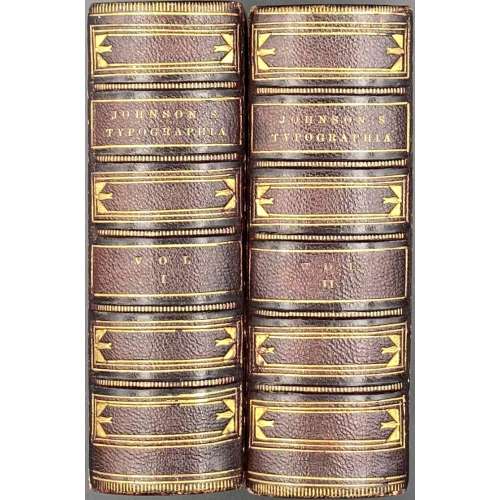 2 volume set, ¾ burgundy morocco over peacock marbled boards, ruled gilt, raised bands, gilt-ruled in compartments, gilt lettering, marbled endpapers and all margins, binding by W. S. Hiltz, NY. Vol. 1. Title: Typographia, | OR THE | Printers' Instructor: | INCLUDING AN ACCOUNT | of the | ORIGIN OF PRINTING, | with | Biographical Notices of the Printers of | England, from Caxton to the close | of the Sixteenth Century : | A Series of | Ancient and Modern Alphabets, | and | DOMESDAY CHARACTERS: | Together with | An Elucidation of every Subject con- | nected with the Art. | By J. JOHNSON, Printer. |{stanza}| Vol. I. | In frame: Published by Messrs. Longman, Hurst, | Rees, Orme, Brown & Green, Pater- | noster Row, London | Under the frame: 1824. || Pagination: Blank leaf, [2] – blank / engraved frontispiece (portrait of William Caxton by W. Hughes) w/guard, [2] – engraved t.p. by Thompson (upper margin almost none, tall lower margin, unframed) / blank, letterpress t.p. w/guard / blank, [2] – dedication to Earl Spenser and Roxburghe Club members / list of members, [2] – engraved Roxburgh Club plate by W. Hughes / blank, [4] – the pedigree of Earl Spenser, [i] ii-xii preface, [1] 2-610, [10] – index, blank leaf; printed on wove paper, text within double rule border. Vol. 2. Title: Typographia, | OR THE | Printers' Instructor: | INCLUDING AN ACCOUNT | of the | ORIGIN OF PRINTING, | with | Biographical Notices of the Printers of | England, from Caxton to the close | of the Sixteenth Century : | A Series of | Ancient and Modern Alphabets, | and | DOMESDAY CHARACTERS: | Together with | An Elucidation of every Subject con- | nected with the Art. | By J. JOHNSON, Printer. |{stanza}| Vol. II. | In frame: Published by Messrs. Longman, Hurst, | Rees, Orme, Brown & Green, Pater- | noster Row, London | Under the frame: 1824. || Pagination: Blank leaf, [2] – blank / engraved frontispiece (portrait of John Johnson ÆTATIS XLVI by William Harvey), w/o guard, [2] – engraved t.p. by G. W. Bonner (framed) / blank, letterpress t.p. w/o guard / blank, [2] – advert. / explanation of engraved title, [i]-iv contents, [1, 2] 3-663 [664], [14] – index, [2] – cantata, blank leaf; printed on wove paper, text within double rule border. Note: This is the book that served as a source of plagiarism for Adams's Typographia: a brief sketch of the origin, rise, and progress of the typographic art published in Philadelphia by himself in 1837.
2 volume set, ¾ burgundy morocco over peacock marbled boards, ruled gilt, raised bands, gilt-ruled in compartments, gilt lettering, marbled endpapers and all margins, binding by W. S. Hiltz, NY. Vol. 1. Title: Typographia, | OR THE | Printers' Instructor: | INCLUDING AN ACCOUNT | of the | ORIGIN OF PRINTING, | with | Biographical Notices of the Printers of | England, from Caxton to the close | of the Sixteenth Century : | A Series of | Ancient and Modern Alphabets, | and | DOMESDAY CHARACTERS: | Together with | An Elucidation of every Subject con- | nected with the Art. | By J. JOHNSON, Printer. |{stanza}| Vol. I. | In frame: Published by Messrs. Longman, Hurst, | Rees, Orme, Brown & Green, Pater- | noster Row, London | Under the frame: 1824. || Pagination: Blank leaf, [2] – blank / engraved frontispiece (portrait of William Caxton by W. Hughes) w/guard, [2] – engraved t.p. by Thompson (upper margin almost none, tall lower margin, unframed) / blank, letterpress t.p. w/guard / blank, [2] – dedication to Earl Spenser and Roxburghe Club members / list of members, [2] – engraved Roxburgh Club plate by W. Hughes / blank, [4] – the pedigree of Earl Spenser, [i] ii-xii preface, [1] 2-610, [10] – index, blank leaf; printed on wove paper, text within double rule border. Vol. 2. Title: Typographia, | OR THE | Printers' Instructor: | INCLUDING AN ACCOUNT | of the | ORIGIN OF PRINTING, | with | Biographical Notices of the Printers of | England, from Caxton to the close | of the Sixteenth Century : | A Series of | Ancient and Modern Alphabets, | and | DOMESDAY CHARACTERS: | Together with | An Elucidation of every Subject con- | nected with the Art. | By J. JOHNSON, Printer. |{stanza}| Vol. II. | In frame: Published by Messrs. Longman, Hurst, | Rees, Orme, Brown & Green, Pater- | noster Row, London | Under the frame: 1824. || Pagination: Blank leaf, [2] – blank / engraved frontispiece (portrait of John Johnson ÆTATIS XLVI by William Harvey), w/o guard, [2] – engraved t.p. by G. W. Bonner (framed) / blank, letterpress t.p. w/o guard / blank, [2] – advert. / explanation of engraved title, [i]-iv contents, [1, 2] 3-663 [664], [14] – index, [2] – cantata, blank leaf; printed on wove paper, text within double rule border. Note: This is the book that served as a source of plagiarism for Adams's Typographia: a brief sketch of the origin, rise, and progress of the typographic art published in Philadelphia by himself in 1837. -
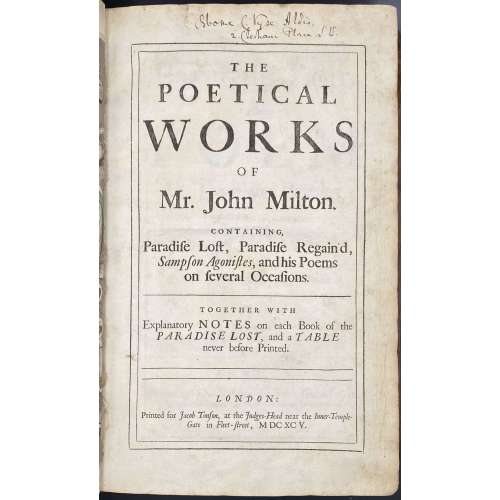 THE | POETICAL | WORKS | OF | Mr. John Milton. | Paradise Lost, Paradise Regained, | Sampson Agonistes, and his Poems | on several Occasions. | TOGETHER WITH | Explanatory NOTES on each Book of the | PARADISE LOST, and a TABLE | never before Printed. | LONDON: | Printed for Jacob Tonson, at Judges-Head near Inner-Temple-| Gate in Fleet – street , M DC XC V. || Pagination: [6] 1-343 [5] 1-66 [4] 1-57 [5] 1-60 [2] 321 [1], frontispiece and 12 plates, one before each book of Paradise Lost. Collation: 4to, folio; blank leaf, π3 B2, C-Z4, Aa-Yy4, A-H4 I2, [A]-D2 †D2 E-Q2 [A]1 B-Z2 Aa-Zz2 Aaa-Zzz2 Aaaa-Mmmm2 [N]1, 2 blank leaves, + frontis. portrait and 12 plates extraneous to collation. Plates: Portrait of John Milton (British, 1608 – 1674) engraved by Robert White (British, 1645 – 1703) after William Faithorne (British, 1616 – 1691) 11 plates engraved by Michael Burghers (Dutch, c. 1640 – c. 1723) after John Baptiste de Medina (Flemish, 1659 –1710); 1 plate (for Book IV) engraved by Peter-Paul Bouché (Dutch, 1646 – c. 1697) after Bernard Lens (British, 1659 – 1725). Binding: Folio, bound in full contemporary English panelled and speckled calf, tooled in blind, re-backed, corners repaired, the lines in Paradise Lost numbered; title pages of Paradise Regain'd and Samson Agonistes dated 1695; without a list of subscribers after the general title; with the Table for Paradise Lost; printed on laid paper, with tall "s", margins sprayed red. Provenance: near-contemporary ex libris of Sarah Bugg inside front board; along with that of Sam Bontham, 1726; later owned by forger Osborne Charles Vyse Aldis (1843 – 1916), with his signature on general title, with a nine-line note in his hand and initialled on page 343. Catalogue raisonné: Gordon N. Ray, Illustrated book in England (1976): p. 3. Ref: National Gallery of Art Contributors: Bouché, Peter-Paul (Dutch, 1646 – c. 1697) Burghers, Michael (Dutch, c. 1640 – c. 1723) Faithorne, William (British, 1616 – 1691) Lens, Bernard (British, 1659 – 1725) Medina, John Baptiste de (Flemish, 1659 – 1710) Milton, John (British, 1608 – 1674) Tonson, Jacob, the Elder (British, 1655 – 1736) White, Robert (British, 1645 – 1703)
THE | POETICAL | WORKS | OF | Mr. John Milton. | Paradise Lost, Paradise Regained, | Sampson Agonistes, and his Poems | on several Occasions. | TOGETHER WITH | Explanatory NOTES on each Book of the | PARADISE LOST, and a TABLE | never before Printed. | LONDON: | Printed for Jacob Tonson, at Judges-Head near Inner-Temple-| Gate in Fleet – street , M DC XC V. || Pagination: [6] 1-343 [5] 1-66 [4] 1-57 [5] 1-60 [2] 321 [1], frontispiece and 12 plates, one before each book of Paradise Lost. Collation: 4to, folio; blank leaf, π3 B2, C-Z4, Aa-Yy4, A-H4 I2, [A]-D2 †D2 E-Q2 [A]1 B-Z2 Aa-Zz2 Aaa-Zzz2 Aaaa-Mmmm2 [N]1, 2 blank leaves, + frontis. portrait and 12 plates extraneous to collation. Plates: Portrait of John Milton (British, 1608 – 1674) engraved by Robert White (British, 1645 – 1703) after William Faithorne (British, 1616 – 1691) 11 plates engraved by Michael Burghers (Dutch, c. 1640 – c. 1723) after John Baptiste de Medina (Flemish, 1659 –1710); 1 plate (for Book IV) engraved by Peter-Paul Bouché (Dutch, 1646 – c. 1697) after Bernard Lens (British, 1659 – 1725). Binding: Folio, bound in full contemporary English panelled and speckled calf, tooled in blind, re-backed, corners repaired, the lines in Paradise Lost numbered; title pages of Paradise Regain'd and Samson Agonistes dated 1695; without a list of subscribers after the general title; with the Table for Paradise Lost; printed on laid paper, with tall "s", margins sprayed red. Provenance: near-contemporary ex libris of Sarah Bugg inside front board; along with that of Sam Bontham, 1726; later owned by forger Osborne Charles Vyse Aldis (1843 – 1916), with his signature on general title, with a nine-line note in his hand and initialled on page 343. Catalogue raisonné: Gordon N. Ray, Illustrated book in England (1976): p. 3. Ref: National Gallery of Art Contributors: Bouché, Peter-Paul (Dutch, 1646 – c. 1697) Burghers, Michael (Dutch, c. 1640 – c. 1723) Faithorne, William (British, 1616 – 1691) Lens, Bernard (British, 1659 – 1725) Medina, John Baptiste de (Flemish, 1659 – 1710) Milton, John (British, 1608 – 1674) Tonson, Jacob, the Elder (British, 1655 – 1736) White, Robert (British, 1645 – 1703) -
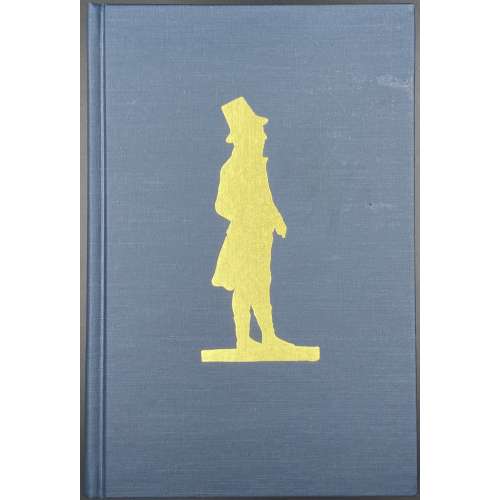 Title: THOMAS FROGNALL DIBDIN | 1776-1847 | A Bibliography | By John Windle and Karma Pippin | Oak Knoll Press | New Castle Delaware | 1999 || Pagination: [2 blanks] [i, ii] – standing silhouette / frontis. with buste portrait 1821 (misspelled "Didbin"), [iii, iv] – t.p. / colophon, [v, vi] – dedication / blank, [vii, viii] – contents / blank, [ix, x] – illustr. / portrait 1816, [xi] xii-xxiii [xxiv] [1] 2-284 [2]. Binding: 23.5 x 16 cm, hardcover, publisher’s blue cloth gilt-stamped with a standing silhouette of T. F. Dibdin to cover, gilt lettering to spine.
Title: THOMAS FROGNALL DIBDIN | 1776-1847 | A Bibliography | By John Windle and Karma Pippin | Oak Knoll Press | New Castle Delaware | 1999 || Pagination: [2 blanks] [i, ii] – standing silhouette / frontis. with buste portrait 1821 (misspelled "Didbin"), [iii, iv] – t.p. / colophon, [v, vi] – dedication / blank, [vii, viii] – contents / blank, [ix, x] – illustr. / portrait 1816, [xi] xii-xxiii [xxiv] [1] 2-284 [2]. Binding: 23.5 x 16 cm, hardcover, publisher’s blue cloth gilt-stamped with a standing silhouette of T. F. Dibdin to cover, gilt lettering to spine. -
![Romeyn De Hooghe: Virtuoso Etcher / Joseph B. Dallett [Introduction]; Andrew C. Weislogel [Preface]; Andrew C. Weislogel [Editor]; Tatyana Petukhova LaVine [Contributor]. – Ithaca, NY: Herbert F. Johnson Museum of Art, Cornell University, 2009. – pp.: [1-5] 6-96, ill.](https://varshavskycollection.com/wp-content/uploads/2021/02/LIB-2521.2020-a-500x500.jpeg) Title page: ROMEYN DE HOOGHE | VIRTUOSO ETCHER | JOSEPH B. DALLETT | with | Tatyana Petukhova LaVine | edited by | Andrew C. Weislogel | HERBERT F. JOHNSON MUSEUM OF ART | CORNELL UNIVERSITY || Pagination: [1-5] 6-96; 57 entries, bibliography. Binding: 28 x 21.7 cm, publisher’s pictorial wrappers. Contributors: Romeyn de Hooghe (Dutch, 1645 – 1708) Joseph B. Dallett – author/introduction. Andrew C. Weislogel – editor. Tatyana Petukhova LaVine – contributor.
Title page: ROMEYN DE HOOGHE | VIRTUOSO ETCHER | JOSEPH B. DALLETT | with | Tatyana Petukhova LaVine | edited by | Andrew C. Weislogel | HERBERT F. JOHNSON MUSEUM OF ART | CORNELL UNIVERSITY || Pagination: [1-5] 6-96; 57 entries, bibliography. Binding: 28 x 21.7 cm, publisher’s pictorial wrappers. Contributors: Romeyn de Hooghe (Dutch, 1645 – 1708) Joseph B. Dallett – author/introduction. Andrew C. Weislogel – editor. Tatyana Petukhova LaVine – contributor. -
 Title page: THE | SECRET AGENT | A SIMPLE TALE | BY | JOSEPH CONRAD | METHUEN & CO. | 36 ESSEX STREET W.C. | LONDON || Imprint on t.p. verso: First Published in 1907 Dedication: To H. G. Wells. Pagination: [2] – blank, [6] – h.t., t.p., dedication; 1-442, [2] colophon: THE RIVERSIDE PRESS LIMITED, EDINBURGH / blank; [1-2] 3-40 – Catalogue of books published by Methuen and company, September 1907; total 492 pages. Collation: 8vo; π4, A-Z8 2A-2D8, 2E6, + 20 leaves of advertisement: signed A2 on leaf 5 and A3 on leaf 9, other unsigned, 2E2 signed; total 246 leaves. Binding: Publisher’s burgundy cloth with gilt lettering and elements to spine, lower margin untrimmed, 19.5 x 13.5 cm. Edition: 1st edition, 1st printing ("be be" on the last line of page 117) of 2,500 copied printed. Contributors: Conrad, Joseph (Polish-British, 1857 – 1924) – author. Methuen & Co. (London) – publisher. The Riverside Press Limited (Edinburgh) – printer. Herbert George Wells (British, 1866 – 1946) – dedicatee.
Title page: THE | SECRET AGENT | A SIMPLE TALE | BY | JOSEPH CONRAD | METHUEN & CO. | 36 ESSEX STREET W.C. | LONDON || Imprint on t.p. verso: First Published in 1907 Dedication: To H. G. Wells. Pagination: [2] – blank, [6] – h.t., t.p., dedication; 1-442, [2] colophon: THE RIVERSIDE PRESS LIMITED, EDINBURGH / blank; [1-2] 3-40 – Catalogue of books published by Methuen and company, September 1907; total 492 pages. Collation: 8vo; π4, A-Z8 2A-2D8, 2E6, + 20 leaves of advertisement: signed A2 on leaf 5 and A3 on leaf 9, other unsigned, 2E2 signed; total 246 leaves. Binding: Publisher’s burgundy cloth with gilt lettering and elements to spine, lower margin untrimmed, 19.5 x 13.5 cm. Edition: 1st edition, 1st printing ("be be" on the last line of page 117) of 2,500 copied printed. Contributors: Conrad, Joseph (Polish-British, 1857 – 1924) – author. Methuen & Co. (London) – publisher. The Riverside Press Limited (Edinburgh) – printer. Herbert George Wells (British, 1866 – 1946) – dedicatee. -
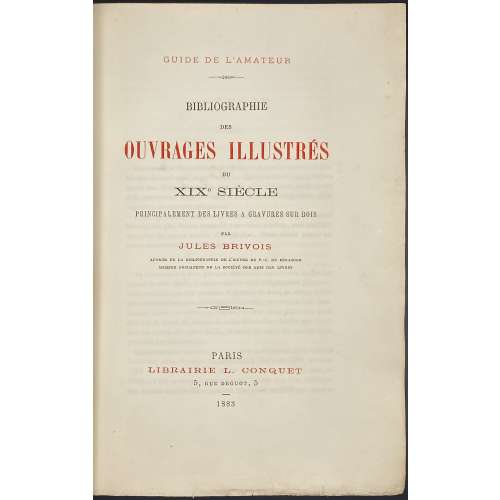 Title page: GUIDE DE L’AMATEUR | BIBLIOGRAPHIE | DES | OUVRAGES ILLUSTRES | DU | XIXe SIÈCLE | PRINCIPALEMENT DES LIVRES A GRAVURES SUR BOIS | PAR | JULES BRIVOIS | AUTEUR DE LA BIBLIOGRAPHIE DE L’ŒUVRE DE P.-J. BÉRANGER | MEMBRE FONDATEUR DE LA SOCIÉTÉ DES AMIS DES LIVRES | — | PARIS | LIBRAIRIE L. CONQUET | 5, RUE DROUOT, 5 | 1883 || Justification: Il a été tire : | 900 exemplaires sur papier vergé. | Et 50 exemplaires sur grand papier de Hollande. | Tous sont numérotés et paraphes par l’auteur. | № {188 signature} | Les numéros pairs portent le nom de M. L. Conquet. | Et les numéros impairs celui de M. P. Rouquette. | — | Le dépôt légal sera fait en France et dans tous les pays avec lesquels il | existe des conventions pour la propriété littéraire. | Tous droits réservés. || Pagination : [2] blank, [i-v] vi-xiii [xiv], [1] 2-468; the total number of pages = 484. Collation: π8 1-288 2910, an asterisk on leaf 295; the total number of leaves 242; 3 blank leaves of wove paper before and after collation. Imprint to 11 : Imp. de Mme de Lacombe; Imprint to 2910 : Nancy, imprimerie Berger-Levrault et Cie. Binding: ¾ polished distressed calf over marbled boards by the previous owner "E.D", gilt-stamped spine with gilt-lettered black label, peacock marbled endpapers, printed on laid paper. Contributors: Jules Brivois (French, 1832 – 1920) – author. L. Conquet (Paris) – publisher. P. Rouquette (Paris) – publisher. Berger-Levrault et Cie – printer.
Title page: GUIDE DE L’AMATEUR | BIBLIOGRAPHIE | DES | OUVRAGES ILLUSTRES | DU | XIXe SIÈCLE | PRINCIPALEMENT DES LIVRES A GRAVURES SUR BOIS | PAR | JULES BRIVOIS | AUTEUR DE LA BIBLIOGRAPHIE DE L’ŒUVRE DE P.-J. BÉRANGER | MEMBRE FONDATEUR DE LA SOCIÉTÉ DES AMIS DES LIVRES | — | PARIS | LIBRAIRIE L. CONQUET | 5, RUE DROUOT, 5 | 1883 || Justification: Il a été tire : | 900 exemplaires sur papier vergé. | Et 50 exemplaires sur grand papier de Hollande. | Tous sont numérotés et paraphes par l’auteur. | № {188 signature} | Les numéros pairs portent le nom de M. L. Conquet. | Et les numéros impairs celui de M. P. Rouquette. | — | Le dépôt légal sera fait en France et dans tous les pays avec lesquels il | existe des conventions pour la propriété littéraire. | Tous droits réservés. || Pagination : [2] blank, [i-v] vi-xiii [xiv], [1] 2-468; the total number of pages = 484. Collation: π8 1-288 2910, an asterisk on leaf 295; the total number of leaves 242; 3 blank leaves of wove paper before and after collation. Imprint to 11 : Imp. de Mme de Lacombe; Imprint to 2910 : Nancy, imprimerie Berger-Levrault et Cie. Binding: ¾ polished distressed calf over marbled boards by the previous owner "E.D", gilt-stamped spine with gilt-lettered black label, peacock marbled endpapers, printed on laid paper. Contributors: Jules Brivois (French, 1832 – 1920) – author. L. Conquet (Paris) – publisher. P. Rouquette (Paris) – publisher. Berger-Levrault et Cie – printer. -
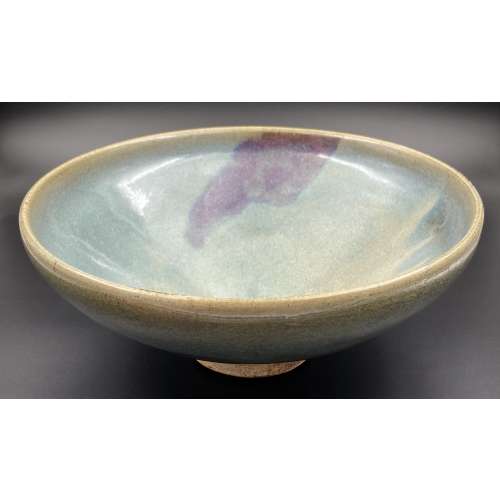 Bowl with tapered sides, lavender-blue glaze and a large purple splash on the interior; yellowish rim; foot unglazed. China, the Yuan Dynasty [大元] (1279 – 1368). Diameter: 21 cm; Height: 9 cm.
Bowl with tapered sides, lavender-blue glaze and a large purple splash on the interior; yellowish rim; foot unglazed. China, the Yuan Dynasty [大元] (1279 – 1368). Diameter: 21 cm; Height: 9 cm. -
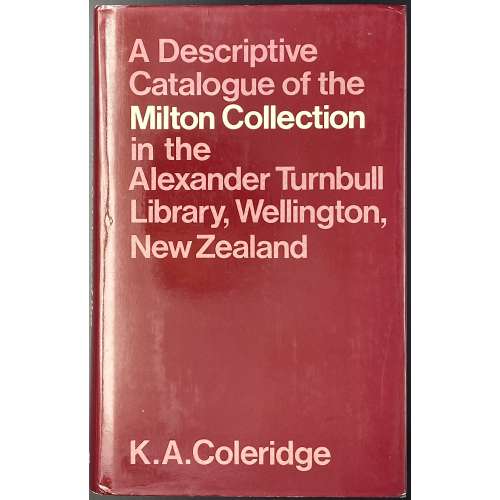 Title page: A DESCRIPTIVE CATALOGUE | OF THE | MILTON COLLECTION | IN THE ALEXANDER | TURNBULL LIBRARY, | WELLINGTON, | NEW ZEALAND |Describing works printed before 1801 | held in the Library at December 1975 | COMPILED BY | K. A. COLERIDGE | Published for the Alexander Turnbull Library, | National Library of New Zealand, | by OXFORD UNIVERSITY PRESS | 1980. Pagination: [i-v] vi-xxv [xxvi blank], [1] 2-536, plus 27 leaves with 60 plates. Printer: Printed in Great Britain at the Pitman Press, Bath. Size: 22.5 x 14.5 cm. Binding: Black cloth, gilt lettering to spine, lettered maroon dust-jacket, unclipped (£35.00 net in UK). Contributor: Kathleen A. Coleridge (New Zealand, b. 1944).
Title page: A DESCRIPTIVE CATALOGUE | OF THE | MILTON COLLECTION | IN THE ALEXANDER | TURNBULL LIBRARY, | WELLINGTON, | NEW ZEALAND |Describing works printed before 1801 | held in the Library at December 1975 | COMPILED BY | K. A. COLERIDGE | Published for the Alexander Turnbull Library, | National Library of New Zealand, | by OXFORD UNIVERSITY PRESS | 1980. Pagination: [i-v] vi-xxv [xxvi blank], [1] 2-536, plus 27 leaves with 60 plates. Printer: Printed in Great Britain at the Pitman Press, Bath. Size: 22.5 x 14.5 cm. Binding: Black cloth, gilt lettering to spine, lettered maroon dust-jacket, unclipped (£35.00 net in UK). Contributor: Kathleen A. Coleridge (New Zealand, b. 1944). -
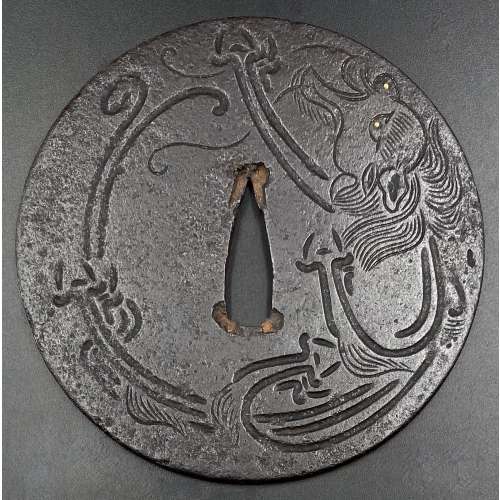 Iron tsuba of round form, on both sides decorated in low relief (kebori) with a dragon, eyes inlaid in brass. NBTHK: Hozon, № 4011013. Kamakura-bori type of tsuba. Med-Muromachi period, c. 1450. Diameter: 90 mm; Thickness (centre): 3.3 cm, Thickness (rim): 2.4 cm Reference: Japanese Swords and Sword Fittings from the Collection of Dr Walter Ames Compton (Part I). — NY: Christie's, 1992, p. 10, №2. Obviously, Compton's tsuba has an altered nakago-ana and placed on the photo upside down. Compton's tsuba has a raised mimi, while mine does not.
Iron tsuba of round form, on both sides decorated in low relief (kebori) with a dragon, eyes inlaid in brass. NBTHK: Hozon, № 4011013. Kamakura-bori type of tsuba. Med-Muromachi period, c. 1450. Diameter: 90 mm; Thickness (centre): 3.3 cm, Thickness (rim): 2.4 cm Reference: Japanese Swords and Sword Fittings from the Collection of Dr Walter Ames Compton (Part I). — NY: Christie's, 1992, p. 10, №2. Obviously, Compton's tsuba has an altered nakago-ana and placed on the photo upside down. Compton's tsuba has a raised mimi, while mine does not.
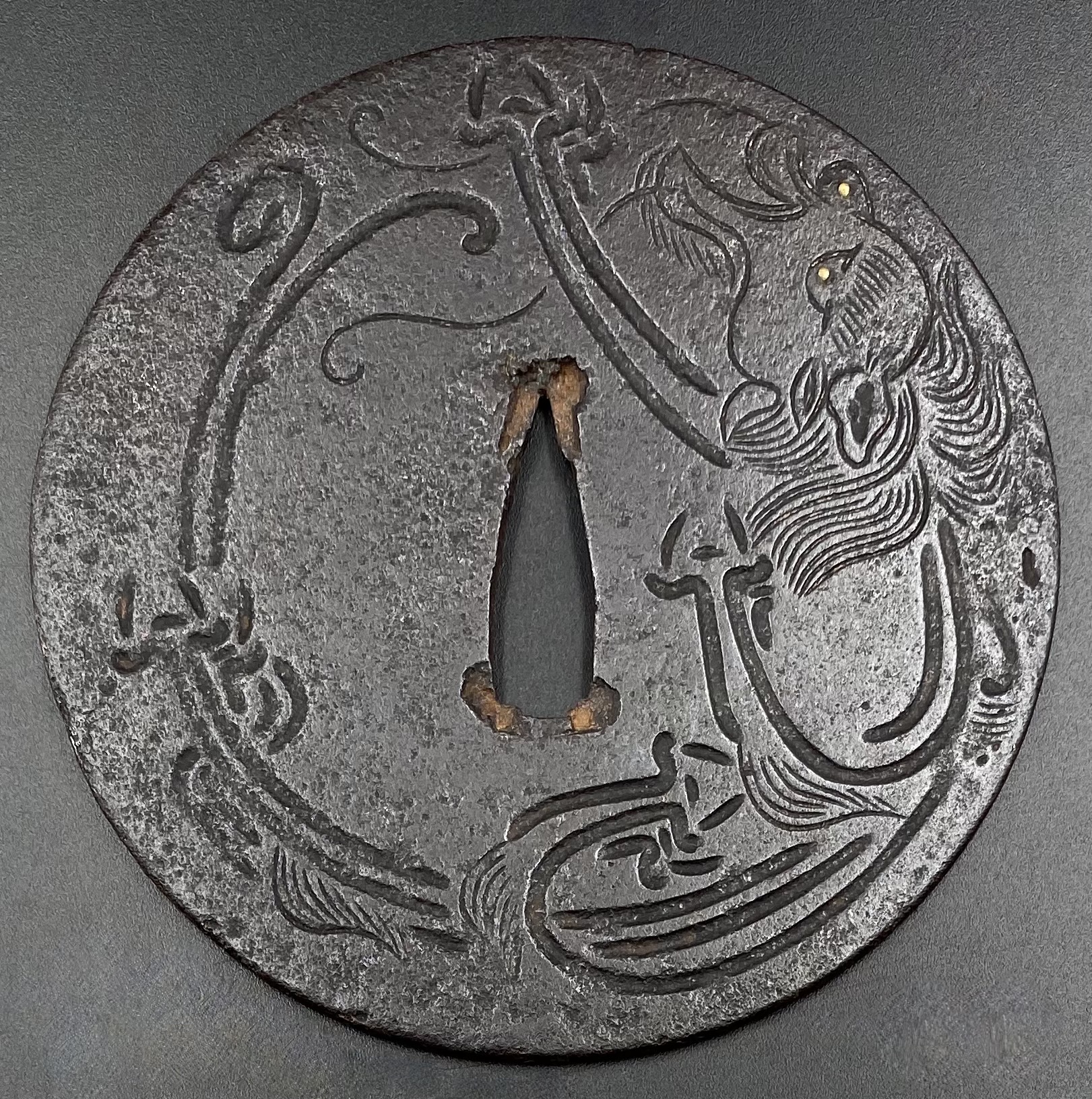 Two other examples of the same design may be found at: (1) Christie, Manson & Woods auction sales “Kotetsu”, 1980, page 12, №10 and (2) Professor A. Z. Freeman and the Phyllis Sharpe Memorial collections №36, pp. 18-19. Both have raised mimi, the latter classified as Katchushi tsuba.
More about Kamakura-bori tsuba here.
Two other examples of the same design may be found at: (1) Christie, Manson & Woods auction sales “Kotetsu”, 1980, page 12, №10 and (2) Professor A. Z. Freeman and the Phyllis Sharpe Memorial collections №36, pp. 18-19. Both have raised mimi, the latter classified as Katchushi tsuba.
More about Kamakura-bori tsuba here.
-
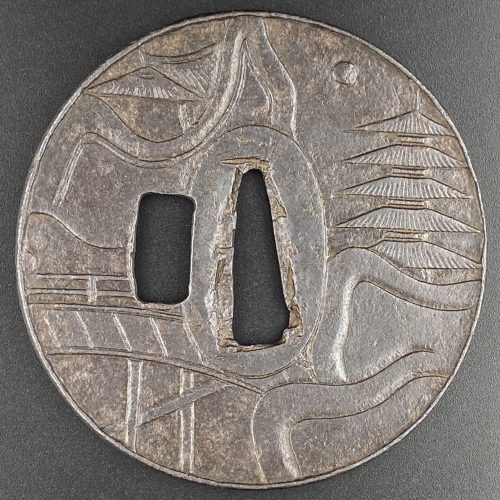
The thin iron plate of round form and black colour carved in sukidashi-bori with the design of rocks, waves, bridge, mountain pavilion and 5-storey pagoda under the moon, on both sides, alluding to Todai-ji temple in Nara. Slightly rounded rectangular hitsu-ana probably pierced later. Very narrow raised rim as usual in katsushi tsuba. In a modern wooden box.
Late Muromachi period, 16th century. Dimensions: 81.1 x 79.5 x 3. mm (seppa-dai), 2.2 mm (base plate), 4.4. (rim).Reference: “Art of the Samurai” on page 232, №140: ”Kamakura tsuba with Sangatsu-do tower and bridge. Muromachi period, 16th century. 83 mm x 80 mm. Unsigned. Tokyo National Museum. The mountain pavilion and bridge carved in sunken relief on the iron tsuba – both part of Tōdai-ji, a temple in Nara – are detailed in fine kebori (line) engraving. As a result of the chiselling used to create the relief, the ground of the piece is relatively thin”. Also page 41 in Tsuba Kanshoki. Kazutaro Torogoye, 1975 [LIB-1480.2018].
This tsuba is very much similar to TSU-0384. -
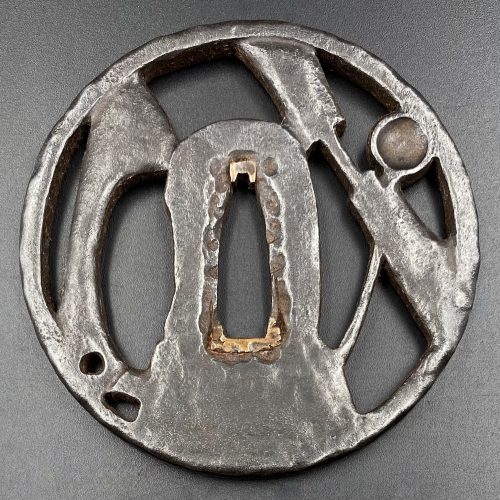 Iron tsuba of round form decorated with a ladle, pestle, mortar, and rice sickle in positive silhouette openwork (nikubori-ji-sukashi). Slightly rounded rim with iron bones (tekkotsu). Seppa-dai plugged with copper fittings (sekigane). Silver patina. The design resembles mochi-making utensils; mochi (rice cake) symbolizes longevity. Kanayama school, c. 1590 (Momoyama period). Note: unusually large size for a Kanayama tsuba: diameter 79.5 mm, thickness at seppa-dai: 5.5 mm, at rim: 6.0 mm. Concerning the design: While the ladle and pestle are clear, the mortar (under the seppa-dai), and the sickle (to the left) require certain imagination.
Iron tsuba of round form decorated with a ladle, pestle, mortar, and rice sickle in positive silhouette openwork (nikubori-ji-sukashi). Slightly rounded rim with iron bones (tekkotsu). Seppa-dai plugged with copper fittings (sekigane). Silver patina. The design resembles mochi-making utensils; mochi (rice cake) symbolizes longevity. Kanayama school, c. 1590 (Momoyama period). Note: unusually large size for a Kanayama tsuba: diameter 79.5 mm, thickness at seppa-dai: 5.5 mm, at rim: 6.0 mm. Concerning the design: While the ladle and pestle are clear, the mortar (under the seppa-dai), and the sickle (to the left) require certain imagination. -
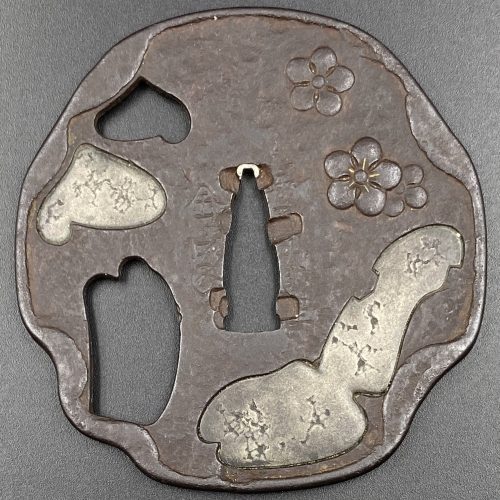
A very thin kobushi-gata form iron tsuba decorated in openwork (sukashi), some openings filled with grey metal (silver or pewter) treated in a way to resemble cracked ice, ginkgo leaf to recto and plum blossoms to verso in low-relief (takabori) and gold inlay (zōgan), and unevenly folded over rim (hineri-mimi). The overall theme of the piece is linked to the icy ponds, falling ginkgo leaves and blossoming plums in the late winter.
Size: 84 x 80 mm, thickness (center): 2 mm.Signed: Yamashiro no kuni Fushimi no ju Kaneie [Kaneie of Fushimi in Yamashiro Province] [山城國伏見住金家], with Kaō.
Probably the work of Meijin-Shodai Kaneie (c. 1580 – 1600).
The silver or pewter inlays likely a later work that may be attributed to Goto Ichijo (1791 – 1876) or one of his apprentices in the late 19th century, possibly as a tribute to the great Kaneie masters. Here is an article by Steve Waszak dedicated to Kaneie masters and this tsuba in particular.Kaneie
For many tosogu aficionados, this name reigns supreme among all tsubako across Japanese history. The first Kaneie is celebrated for many things. He is recognized as being the first ever to bring pictorial landscape subjects to a canvas so small as that of a tsuba plate. His skill in being able to render classical Chinese landscape themes while working with a material as unyielding as steel, and to do so with the sensitivity he does, is nothing short of astounding. The quality of his workmanship — especially that of his exquisitely carved motif elements and the extraordinary deftness of his tsuchime (槌目 or 鎚目, hammer-blow) utilizing such thin plates — astonishes even to this day. His sensibilities concerning the shaping of his sword guards and the presentation of the rims were no less innovative than his subject matter. He was among the very first to regularly sign his name as a tsuba smith. And it is likely that he served the great warlord Toyotomi Hideyoshi in the latter years of the 16th century. Despite the great fame and reputation of Kaneie, very little of the lives of the two men who are seen by most scholars as the “true Kaneie” tsubako of the Momoyama and earliest Edo Periods is known to us now. They were both smiths working in steel, with occasional added soft-metal inlay (usually serving to highlight features), and both made sword guards of the same style, using subject matter focused on landscapes, allusions to historical events, or religious themes. The first of these men is often referred to as “O-Shodai,” or Great First Generation, while the second is known as “Meijin-Shodai,” or Famous First Generation. While some see subsequent generations stemming from these first two men, others have the O-Shodai and the Meijin-Shodai as THE two true Kaneie and make a sharp distinction between these two smiths and any others who may share the name.The work of the O-Shodai may appear with two different mei. One of these is written “Joshu Fushimi Ju Kaneie,” while his work may also carry a mei reading “Yamashiro no Kuni Fushimi Ju Kaneie.” It is thought by some scholars that the earlier works present with the “Joshu” mei, while his later works feature the “Yamashiro” mei. However, there are only some five or six tsuba extant with the “Joshu” signature, so we should not necessarily see works with the “Yamashiro” signature as dating only to the latest years of his working life. The answers to the questions of exactly when Kaneie might have begun his life as a tsubako, or how old he was when he moved to sign his works with the “Yamashiro” mei, will probably remain shrouded in uncertainty.The association between Kaneie and Toyotomi Hideyoshi is speculative, to be sure, but the circumstantial evidence is tantalizing. The area of Fushimi is thought to have been an entirely unremarkable land prior to Hideyoshi’s building of a castle there, so it would seem unlikely that the first Kaneie would have been working in such a nondescript place, much less including the place name in his mei, before Hideyoshi’s putting it on the map, so to speak. Why emphasize such pride of place in one’s signature unless the place itself carries a certain weight? The name “Kaneie” translates roughly to “gold family,” which, given Hideyoshi’s notorious love of gold, would seem too much of a coincidence when combined with the explicit mention of Fushimi in the signatures. Combine this with the consideration of what is an equally compelling relationship between the celebrated tsubako Nobuie and Oda Nobunaga (“Nobuie” means roughly “of the family of “Nobu”), whom Hideyoshi served as a top general until Oda’s demise in 1582, and the circumstantial evidence becomes even harder to deny the plausibility of. Oda, ever the innovator, may have been the one responsible for birthing the practice of tsubako regularly signing their works. Having a superb smith like Nobuie affix the name to the tsuba as a regular practice establishes a sort of “brand name,” a brand coming with the seal of approval of Oda Nobunaga. It is more than possible that Nobunaga may have then used these valuable sword guards as rewards given to vassals and other important relations to honour them for their services to him, a practice that would have allowed Nobunaga to avoid having to use gold, guns, swords, horses, or land to do so. The awarding of a magnificent Nobuie tsuba to a deserving warrior, an appreciated ally, or a family member would bring honour to the recipient, of course, but would also honour the maker of the sword guard, and even the giver of the object. Such a way of thinking would be absolutely typical of him, and given that both Oda Nobunaga and Nobuie were men of Kiyosu in Owari in the early Momoyama Period, it does not strain credulity to imagine that the above dynamic could have occurred in just this way. If indeed it did, Toyotomi Hideyoshi is unlikely to have let this pass unnoticed. He may even have been so honoured himself! When he rose to power very shortly after Oda’s death, then, and when he reinforced and consolidated that power in the late 1580s and early 1590s, which included the building of the castle at Fushimi, perhaps he sought to emulate the Oda vision and practice of establishing a “royal tsubako.” If so, Kaneie would have been that smith.As noted, this scenario is speculative, and not a little romantic. This does not mean, however, that it is in fact not likely, for there would be a number of coincidences involved for it to be entirely false.Tsuba scholars will say that Kaneie’s skills in the making of his sword guards indicate an armour-making background. This is an interesting viewpoint, but one can’t help but wonder how many armourers were possessed of such fluent literacy in lyrical Chinese historical tales that they could then represent them as motifs on steel plates. Kaneie subjects often are in the form of Chinese landscapes and allusions, as noted, one of which — The Eight Views of the Xiao and the Xiang — was very well known as a famous subject of Chinese painting and poetry from the Song Dynasty. There exist Kaneie tsuba which depicts at least some of these “views,” and it seems unlikely that if one or more of them were to be created, not all of them would be, in a sort of “series.” The cultural and literary fluency Kaneie would seem to have had, then, may suggest a Buddhist background, and indeed, some of the subjects seen are explicitly Buddhist in nature. Perhaps his background then, somehow offering a dovetailing of metalwork and Buddhist teachings; in any event, we are all the richer for at least some of the works of Kaneie to have survived to reach us today.One of the hallmarks of Kaneie tsuba (real ones) is the extreme thinness of the plate, combined with utterly superb tsuchime expression of that plate. To be able to hammer the plate to achieve such strength of expression while the plate is so thin is seen by the Japanese as practically miraculous. A notable and important kantei point between the early masterpieces by the two “Shodai” Kaneie and the tsuba made by followers is this thinness of the plate. Another kantei point: because the plate is so thin when raised areas representing motif elements are present, they are inlaid into the plate, because trying to carve them from such a thin plate would be practically impossible: the likelihood of piercing the plate would be high, and the plate in that area, even if not pierced, would be significantly weakened by trying to manage the raising of a motif element from the plate. In real Kaneie works, then, one would expect any raised motif elements to be inlaid.Other highlights: the “Shodai” Kaneie are famous for the kobushi-gata (拳形) or “fist-shaped” design in their work, but despite this, there actually aren’t that many extant sword guards boasting this shape. Another feature for which the Kaneie are justly famous is their folding over of the lip of the rim onto the plate in a very tasteful manner, just here and there, rather than uniformly across the tsuba. However, again, this feature is actually not commonly seen, either. The combination, then, of a kobushi-gata shape with the rim folded over in just a few areas is that much rarer.Which brings us to the featured piece.Here is a Kaneie tsuba, a “Meijin-Shodai” Kaneie, which presents with a very thin plate, being between 1.5 and 2mm in thickness. The motif elements are inlaid, as we should expect. The sugata (姿, shape) is Kobushi-gata with the rim folded over in only a few places, representing a relatively infrequently encountered form, as stated. The tsuba here is fortunate not to have any added hitsu-ana, unlike many or most other Kaneie do. The sukashi elements are fascinating to consider, being difficult to determine the meaning of; however, the raised elements clearly point to a seasonal motif, with cherry and plum blossoms on the omote for Spring, and ginkgo on the ura for Fall. The inlaid metal in two of the openings — silver, shibuichi, or pewter, perhaps — is very likely a later addition, probably 19th-century, and more specifically, late-19th-century. The finishing on these inlaid portions has all the hallmarks of Goto Ichijo workmanship. Namely, the treatment of the surface of the inlay to resemble fallen snow (in the Japanese sense of things) is expressed in a very Ichijo sense of things, and, given the great importance of Kaneie tsuba, and the seasonal expression the motif of the guard has, it is plausible that the inlay is Ichijo work or that of one of his top students. In any event, this inlay complements the rest of the tsuba beautifully. The inlay also resembles the art of kintsugi (金継ぎ, golden joinery) or the Japanese practice of ceramic repair using lacquer when a piece is particularly special or important. In this way, a nod is given to Tea Culture, too, creating a wonderful blending of associations and allusions, typical of the highest Japanese aesthetic sense.At 8.4cm, the tsuba is of an excellent size and is in great condition (no rust, no deep rust pitting, no fire damage). There is, intriguingly, one small sign of battle damage at 6:00 on the guard: it would seem a sword blow cut into the tsuba at the rim, and penetrated slightly into the plate. The superb repair represented by a little stitch or two right at the rim and along a few millimetres of the plate is visible on very close inspection. The repair is old, probably nearly contemporary with when the tsuba was made. Given the high status of Kaneie in their lifetime (as tsubako for Hideyoshi, one might imagine their importance), and given the obvious high quality of this piece, it is not surprising that the finest repair efforts were put into its care.The name Kaneie justly enjoys its fame and accolades as pre-eminent among the tens of thousands of tsubako in Japanese history. We are fortunate indeed to have had a small number of the works of the early masters survive to this day. The first of their kind, and as most scholars and aficionados would wholeheartedly agree, the best of their kind, Kaneie sword guards remain among the very finest examples of the Japanese metal-working traditions. -
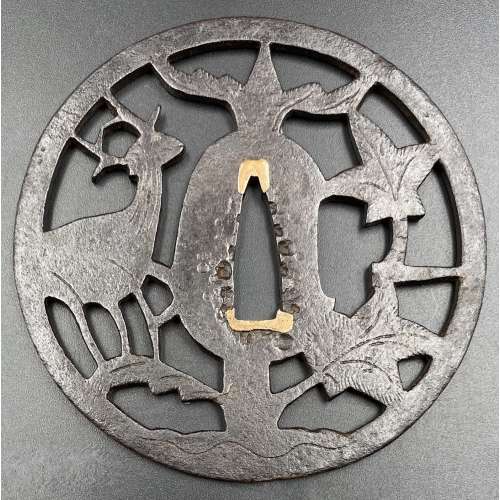
Iron tsuba of round form decorated with a deer and maple leaves in positive silhouette openwork (ji-sukashi), with details finely carved in low relief (kebori). Nakagō-ana plugged with copper fittings (sekigane). Traces of lacquer on the surface.
NBTHK: Hozon, №424947.
Design: An autumnal tsuba with an allusion to Kasuga Shrine in Nara.
Attributed by NBTHK to Shoami. Age: Probably the Momoyama period (1574 – 1603) or early Edo period (1603 – 1650), but judging on the item's substantial size (diameter 86.6 mm) and considerable thinness (3.4 mm) may be attributed to earlier times (late Muromachi period, 1514 – 1573). -
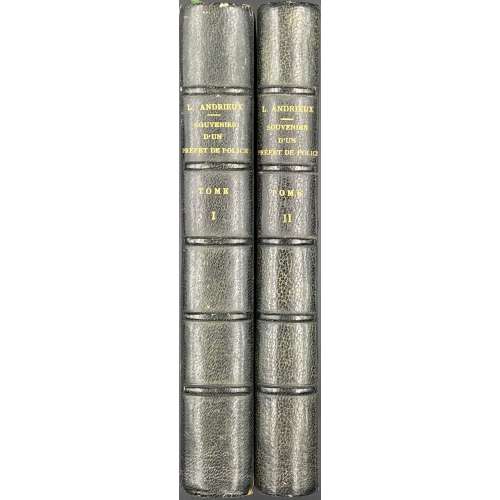 Vol. 1. Title: SOUVENIRS | D'UN | PRÉFET DE POLICE | PAR | L. ANDRIEUX | TOME PREMIER | {publisher’s device} | PARIS | JULES ROUFF ET Cie, ÉDITEURS | 14, CLOITRE SAINT-HONORÉ, 14 | 1885 || Pagination : [1-7] 8-356. Collation: 18mo; 1-1718 1916. Vol. 2. Title: Similar but TOME DEUXIÈME. Pagination : [1-5] 6-304. Collation: 18mo; 1-1518 176. Binding: Both volumes are uniformly bound in quarter black morocco over marbled boards, raised bands, gilt lettering, peacock endpapers, all edges marbled; extensive foxing.
Vol. 1. Title: SOUVENIRS | D'UN | PRÉFET DE POLICE | PAR | L. ANDRIEUX | TOME PREMIER | {publisher’s device} | PARIS | JULES ROUFF ET Cie, ÉDITEURS | 14, CLOITRE SAINT-HONORÉ, 14 | 1885 || Pagination : [1-7] 8-356. Collation: 18mo; 1-1718 1916. Vol. 2. Title: Similar but TOME DEUXIÈME. Pagination : [1-5] 6-304. Collation: 18mo; 1-1518 176. Binding: Both volumes are uniformly bound in quarter black morocco over marbled boards, raised bands, gilt lettering, peacock endpapers, all edges marbled; extensive foxing. -
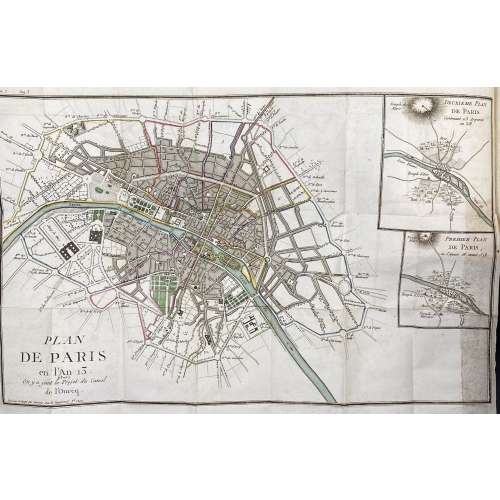 Two volumes, 12mo; 14 x 9 cm, uniformly bound in speckled calf with dentelle border in gilt, gilt-stamped spine with two crimson lettered labels, marbled endpapers. Inscription to h.t.: P. Leigh Smith | Moscow | 1921 || Vol. 1: Half-title: MIROIR | DE L'ANCIEN ET DU NOUVEAU | PARIS, | AVEC TREIZE VOYAGES | EN VÉLOCIFÈRES, |DANS SES ENVIRONS. | TOME I. || Title page: MIROIR | DE L'ANCIEN ET DU NOUVEAU | PARIS, | AVEC TREIZE VOYAGES | EN VÉLOCIFÈRES, |DANS SES ENVIRONS. Ouvrage indespensable aus Étrangers et même | aux Parisiens, et qui indique tout ce qu’il faut | connoître et éviter dans cette capitale. | Orné d’un Plan de Paris et de 18 Gravures | {to the right, in single rules} Tels temps, telles mœurs. | Par L. Prudhomme. | Tome I. | PARIS, | PRUDHOMME, fils, rue des Marais, F. B. St.-G. | DEBRAY, rue St. Honoré, barrière des Sergens. | AN XIII. — (1804.) || Pagination: [i-vii] viii-xxxvi, 1-260; total 296 pages + 15 copperplate engravings and 1 folding plan of Paris. Collation: πA-πC6, A-C6, 4-216 224; total 148 leaves + 15 plates + 1 folding. Note: 12mo; πA1 unsigned, A2 unsigned, A–C3 signed A-C5, respectively, 4* unsigned, 9* marked 8*, 18* marked 17*. Vol. 2: Similar half-title and title, TOME II instead of TOME I. Pagination: [4] 1-408; total 412 pages + 3 copperplate engravings. Collation: π2, 1-346; total 206 leaves + 3 plates.
Two volumes, 12mo; 14 x 9 cm, uniformly bound in speckled calf with dentelle border in gilt, gilt-stamped spine with two crimson lettered labels, marbled endpapers. Inscription to h.t.: P. Leigh Smith | Moscow | 1921 || Vol. 1: Half-title: MIROIR | DE L'ANCIEN ET DU NOUVEAU | PARIS, | AVEC TREIZE VOYAGES | EN VÉLOCIFÈRES, |DANS SES ENVIRONS. | TOME I. || Title page: MIROIR | DE L'ANCIEN ET DU NOUVEAU | PARIS, | AVEC TREIZE VOYAGES | EN VÉLOCIFÈRES, |DANS SES ENVIRONS. Ouvrage indespensable aus Étrangers et même | aux Parisiens, et qui indique tout ce qu’il faut | connoître et éviter dans cette capitale. | Orné d’un Plan de Paris et de 18 Gravures | {to the right, in single rules} Tels temps, telles mœurs. | Par L. Prudhomme. | Tome I. | PARIS, | PRUDHOMME, fils, rue des Marais, F. B. St.-G. | DEBRAY, rue St. Honoré, barrière des Sergens. | AN XIII. — (1804.) || Pagination: [i-vii] viii-xxxvi, 1-260; total 296 pages + 15 copperplate engravings and 1 folding plan of Paris. Collation: πA-πC6, A-C6, 4-216 224; total 148 leaves + 15 plates + 1 folding. Note: 12mo; πA1 unsigned, A2 unsigned, A–C3 signed A-C5, respectively, 4* unsigned, 9* marked 8*, 18* marked 17*. Vol. 2: Similar half-title and title, TOME II instead of TOME I. Pagination: [4] 1-408; total 412 pages + 3 copperplate engravings. Collation: π2, 1-346; total 206 leaves + 3 plates. -
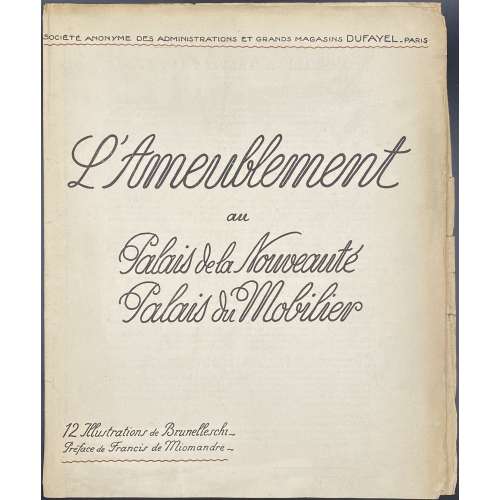 A set of 12 photomechanically reproduced illustrations after gouaches by Umberto Brunelleschi (Italian, 1879 – 1949), in colour; b/w photographs reproductions on verso, in a paper folder without the outer wrappers (b/w with birds, insects, and flowers). Text on the folder by French novelist Francis de Miomandre (French, 1880 – 1959); published by Grands Magasins Dufayel (1856 – 1930), a Parisian department store, run by Georges Dufayel (French, 1855 – 1916). Size: 29 x 24 cm. Images printed on cream paper within a beige frame, lettered above the frame in beige: "Societé Anonyme des Administrations et Grands Magasins DUFAYEL — Paris —", under the frame: "Palais de la Nouveauté ~ Palais du Mobilier | Entrée principale 7 Bould BARBES"; at the bottom of the frame lettered black on each image: Le Style Chinois, Le Style Empire, Le Style Japonais, Le Style Louis XIV, Le Style Louis XV, Le Style Louis XVI, Le Style Moderne (2), Le Style Moyen Age, Le Style Renaissance, Le Style Vénitien, Le Style Persian.
A set of 12 photomechanically reproduced illustrations after gouaches by Umberto Brunelleschi (Italian, 1879 – 1949), in colour; b/w photographs reproductions on verso, in a paper folder without the outer wrappers (b/w with birds, insects, and flowers). Text on the folder by French novelist Francis de Miomandre (French, 1880 – 1959); published by Grands Magasins Dufayel (1856 – 1930), a Parisian department store, run by Georges Dufayel (French, 1855 – 1916). Size: 29 x 24 cm. Images printed on cream paper within a beige frame, lettered above the frame in beige: "Societé Anonyme des Administrations et Grands Magasins DUFAYEL — Paris —", under the frame: "Palais de la Nouveauté ~ Palais du Mobilier | Entrée principale 7 Bould BARBES"; at the bottom of the frame lettered black on each image: Le Style Chinois, Le Style Empire, Le Style Japonais, Le Style Louis XIV, Le Style Louis XV, Le Style Louis XVI, Le Style Moderne (2), Le Style Moyen Age, Le Style Renaissance, Le Style Vénitien, Le Style Persian. -
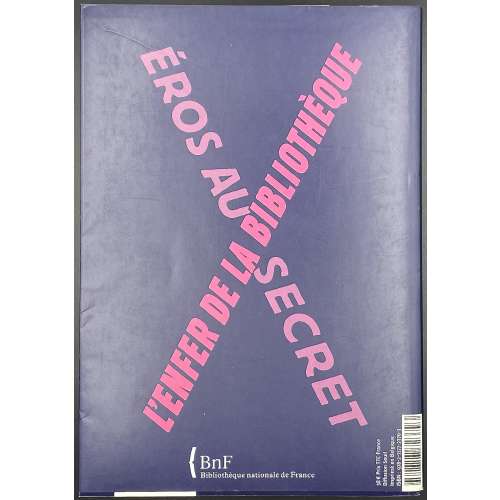 Exhibition held December 4, 2007, to March 2, 2008, at the Bibliothèque Nationale de France. Title: L'enfer de la Bibliothèque | ÉROS AU SECRET | Sous la direction | de Marie-Françoise Quignard | et Raymond-Josué Seckel | [spase] | {BnF | Bibliothèque nationale de France || Description: 23 x 16 cm, publisher’s lettered wrappers and pictorial dust jacket, [1-17] 18-460 [4], ils.; 257 entries, 8 pp. bibliography, 10 pp. index.
Exhibition held December 4, 2007, to March 2, 2008, at the Bibliothèque Nationale de France. Title: L'enfer de la Bibliothèque | ÉROS AU SECRET | Sous la direction | de Marie-Françoise Quignard | et Raymond-Josué Seckel | [spase] | {BnF | Bibliothèque nationale de France || Description: 23 x 16 cm, publisher’s lettered wrappers and pictorial dust jacket, [1-17] 18-460 [4], ils.; 257 entries, 8 pp. bibliography, 10 pp. index. -
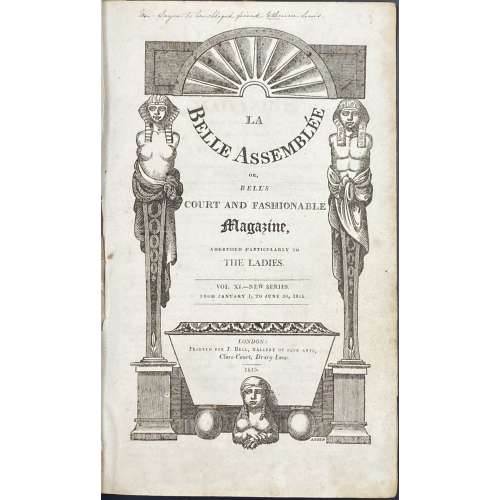 Title: LA | BELLE ASSEMBLÉE | OR, | BELL'S | COURT AND FASHIONABLE | MAGAZINE, | ADDRESSED PARTICULARLY TO | THE LADIES. | VOL. XI.—NEW SERIES. | FROM JANUARY 1, TO JUNE 30, 1815. | LONDON: | Printed for J. BELL, GALLERY OF FINE ARTS, | Clare-Court, Drury-Lane. | 1815. || Pagination: [2] – 11th volume wood-engraved pictorial title page, [1, 2] – January faux-title and table of content, [3] 4-284 [2] – index to 11th vol. Notes: February f.t. not paginated, but within the collation; the last page of the index at the very end paginated [iii]/iv, so pages i/ii missing (the gathering Nn lacking one sheet) Collation: 4to; π1 A-Mm4 Nn3, 28 plates extraneous to collation (lacking 2 plates). Binding: Half brown morocco over marbled boards, flat spine, compartments gilt-ruled with double-fillet and gilt-lettered. Contents: Jan: pp. 1-48, 5 plates. Feb: pp. 51-96, 5 plates. Mar: pp. 97-144, 5 plates. Apr: pp. 145-192, 5 plates. May: pp. 193-240, 5 plates. Jun: pp. 241-284, 3 plates (lacking 2 colour prints). Fashion plates, two per issue, are hand-coloured copperplate engravings, unsigned. Stipple engraved portraits, one per issue as frontispiece: (1) Actress Catherine Stephens, Countess of Essex (British, 1794 – 1882) by James Hopwood the Elder [James Hopwood Senior] (British, c. 1740s/50s – 1819) after Sir George Hayter (British, 1792 – 1871); (2) Madame de Talleyrand, Princesse De Bénévent (Danish-French, 1761– 1834), unsigned, but can be attributed to François Gérard (French, 1770 – 1837); (3) Actress Miss Sarah Booth (1793 – 30 December 1867), unsigned; (4) Group portrait of the French Royal family (Louis XVI, Louis XVII, Marie Antoinette, Madam Elizabeth, Louis Antoine de Bourbon, Duke d'Enghien, and Marie Thérèse Louise of Savoy, Princesse de Lamballe), unsigned, (5) Actress, Miss Sarah Blanche Matthews (b.1794) by Thomas Burke (Irish, 1749 – 1815) after George Hayter. The sixth print, in the March issue, is a lithographic portrait of Napoléon Bonaparte (French, 1769 – 1821), unsigned.
Title: LA | BELLE ASSEMBLÉE | OR, | BELL'S | COURT AND FASHIONABLE | MAGAZINE, | ADDRESSED PARTICULARLY TO | THE LADIES. | VOL. XI.—NEW SERIES. | FROM JANUARY 1, TO JUNE 30, 1815. | LONDON: | Printed for J. BELL, GALLERY OF FINE ARTS, | Clare-Court, Drury-Lane. | 1815. || Pagination: [2] – 11th volume wood-engraved pictorial title page, [1, 2] – January faux-title and table of content, [3] 4-284 [2] – index to 11th vol. Notes: February f.t. not paginated, but within the collation; the last page of the index at the very end paginated [iii]/iv, so pages i/ii missing (the gathering Nn lacking one sheet) Collation: 4to; π1 A-Mm4 Nn3, 28 plates extraneous to collation (lacking 2 plates). Binding: Half brown morocco over marbled boards, flat spine, compartments gilt-ruled with double-fillet and gilt-lettered. Contents: Jan: pp. 1-48, 5 plates. Feb: pp. 51-96, 5 plates. Mar: pp. 97-144, 5 plates. Apr: pp. 145-192, 5 plates. May: pp. 193-240, 5 plates. Jun: pp. 241-284, 3 plates (lacking 2 colour prints). Fashion plates, two per issue, are hand-coloured copperplate engravings, unsigned. Stipple engraved portraits, one per issue as frontispiece: (1) Actress Catherine Stephens, Countess of Essex (British, 1794 – 1882) by James Hopwood the Elder [James Hopwood Senior] (British, c. 1740s/50s – 1819) after Sir George Hayter (British, 1792 – 1871); (2) Madame de Talleyrand, Princesse De Bénévent (Danish-French, 1761– 1834), unsigned, but can be attributed to François Gérard (French, 1770 – 1837); (3) Actress Miss Sarah Booth (1793 – 30 December 1867), unsigned; (4) Group portrait of the French Royal family (Louis XVI, Louis XVII, Marie Antoinette, Madam Elizabeth, Louis Antoine de Bourbon, Duke d'Enghien, and Marie Thérèse Louise of Savoy, Princesse de Lamballe), unsigned, (5) Actress, Miss Sarah Blanche Matthews (b.1794) by Thomas Burke (Irish, 1749 – 1815) after George Hayter. The sixth print, in the March issue, is a lithographic portrait of Napoléon Bonaparte (French, 1769 – 1821), unsigned. -
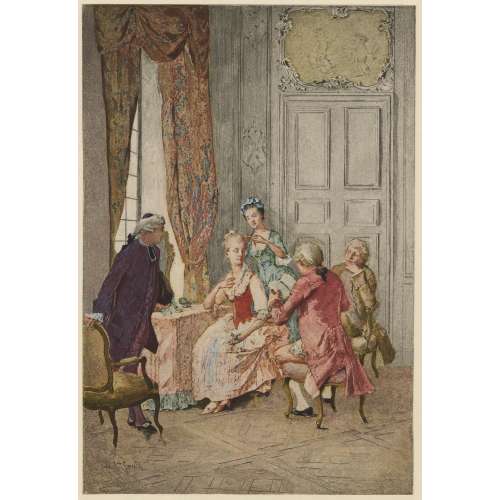
Coloured etching by E. Charreyre (French, fl. 1880 – ?) after a watercolour by Juan Antonio González, (Spanish, 1842 – 1914). A book illustration for 'Son Altesse La Femme' by Octave Uzanne (1851 – 1931), chapter: 'La Caillette' (Le lever d’une petite-maitresse au XVIIIe siècle). Published by Albert Quantin (French, 1850 – 1930) in 1885.
Size: print 17.5 x 12 cm, pasted to leaf 27.7 x 19.5 cm.
-
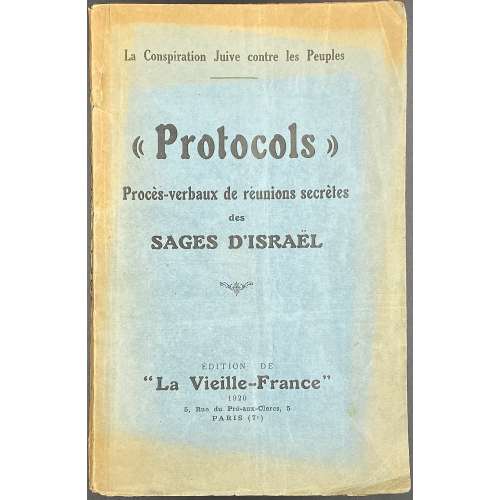 Cover: La Conspiration Juive contre les Peuples | « Protocols » | Procès-verbaux de réunions secrètes | des | SAGES D'ISRAËL | ÉDITION DE | “La Vieille-France” | 1920 | 5Rue du Pré-aux-Clercs, 5 | PARIS (7e) || Title: « Protocols » | Procès-verbaux de réunions secrètes | des | SAGES D'ISRAËL | ÉDITION DE | “La Vieille-France” | 1920 | 5Rue du Pré-aux-Clercs, 5 | PARIS (7e) || Pagination: [1, 2] – t.p. / blank, 3-141 [142 blank] [2] – table / blank. Pp.: 1-11 – Introduction; 13-82 – Protocols; 97-141 – Le Bolchevisme, c’est les Juifs. Collation : 8vo; [1]8 2-98. Binding: Publisher’s blue black-lettered wrappers, lettered spine. Printer: Imprimerie Chantenay (Paris). The French translation of "Протоколы синоских мудрецов" written in Russian by Сергей Нилус (Sergei Nilus, 1862 – 1929) was published in “La Vieille-France” by Urbain Gohier (1862 – 1951). Inside front wrapper: "Brave French! Please note that the format of this book allows you to hide it in your pockets. Your Jewish masters strictly forbid you to read it. Its existence is hidden in every possible way by the Jewish-controlled press. But fear not! While carefully hiding it, read carefully about what your Jewish masters forbid the newspapers to tell you. And you will understand – who and how will take your homeland away from you."
Cover: La Conspiration Juive contre les Peuples | « Protocols » | Procès-verbaux de réunions secrètes | des | SAGES D'ISRAËL | ÉDITION DE | “La Vieille-France” | 1920 | 5Rue du Pré-aux-Clercs, 5 | PARIS (7e) || Title: « Protocols » | Procès-verbaux de réunions secrètes | des | SAGES D'ISRAËL | ÉDITION DE | “La Vieille-France” | 1920 | 5Rue du Pré-aux-Clercs, 5 | PARIS (7e) || Pagination: [1, 2] – t.p. / blank, 3-141 [142 blank] [2] – table / blank. Pp.: 1-11 – Introduction; 13-82 – Protocols; 97-141 – Le Bolchevisme, c’est les Juifs. Collation : 8vo; [1]8 2-98. Binding: Publisher’s blue black-lettered wrappers, lettered spine. Printer: Imprimerie Chantenay (Paris). The French translation of "Протоколы синоских мудрецов" written in Russian by Сергей Нилус (Sergei Nilus, 1862 – 1929) was published in “La Vieille-France” by Urbain Gohier (1862 – 1951). Inside front wrapper: "Brave French! Please note that the format of this book allows you to hide it in your pockets. Your Jewish masters strictly forbid you to read it. Its existence is hidden in every possible way by the Jewish-controlled press. But fear not! While carefully hiding it, read carefully about what your Jewish masters forbid the newspapers to tell you. And you will understand – who and how will take your homeland away from you." -
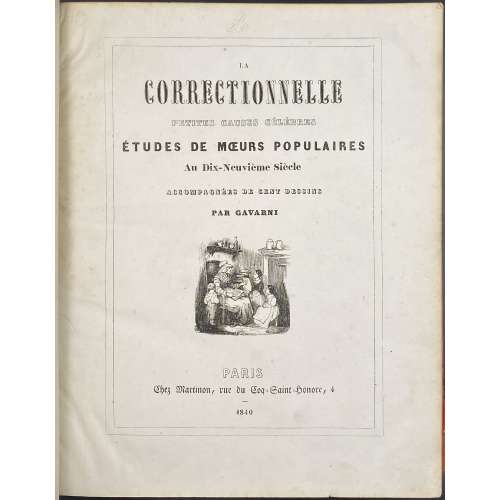 Title-page: LA | CORRECTIONNELLE | PETITES CAUSES CÉLÈBRES | ÉTUDES DE MŒURS POPULAIRES | Au Dix-Neuvième Siècle | ACCOMPAGNÉES DE CENT DESSINS | PAR GAVARNI | {woodcut vignette} | PARIS | Chez Martinon, rue du Coq-Saint-Honoré, 4 | 1840 || Collation: 2o, π3 (t.p. (wrapper?), h.t., t.p.), 1-1012; 205 leaves total, of them 100 plates, lithographs by Gavarni. Pagination: [6] [1] 2-403 [404], 410 pages total, incl. ils. (BnF calls for 426 pages total). Note: plate № 8 is numbered 9, plate № 9 numbered 8; p. 266 numbered 264, p. 268 numbered 266, p. 362 numbered 374, p. 364 numbered 376 (as called for by Carteret). Binding: “Romantique” publisher's quarter calf with gilt lettering and design elements over red paper boards, marbled endpapers. Complete 100 issues of the 4-page “La Correctionnelle” with a woodcut vignette after Gavarni on the 1st page of each issue, published between December 1839 and December 1840, and collected under one cover in 1840 by Martinon. Catalogue raisonné: Carteret (Le trésor, 1927): pp. 177-8; Brivois (1883): p.112. Both authors marked the edition as «rare in good condition". Gavarni [Sulpice Guillaume Chevalier] (French, 1804 – 1866) – artist. Amedée Gratiot et Cie. – printer, text. Coulon et Cie.– printer, lithographs. Coulon, Barthélémy Henry (French, fl. 1839 – ?)
Title-page: LA | CORRECTIONNELLE | PETITES CAUSES CÉLÈBRES | ÉTUDES DE MŒURS POPULAIRES | Au Dix-Neuvième Siècle | ACCOMPAGNÉES DE CENT DESSINS | PAR GAVARNI | {woodcut vignette} | PARIS | Chez Martinon, rue du Coq-Saint-Honoré, 4 | 1840 || Collation: 2o, π3 (t.p. (wrapper?), h.t., t.p.), 1-1012; 205 leaves total, of them 100 plates, lithographs by Gavarni. Pagination: [6] [1] 2-403 [404], 410 pages total, incl. ils. (BnF calls for 426 pages total). Note: plate № 8 is numbered 9, plate № 9 numbered 8; p. 266 numbered 264, p. 268 numbered 266, p. 362 numbered 374, p. 364 numbered 376 (as called for by Carteret). Binding: “Romantique” publisher's quarter calf with gilt lettering and design elements over red paper boards, marbled endpapers. Complete 100 issues of the 4-page “La Correctionnelle” with a woodcut vignette after Gavarni on the 1st page of each issue, published between December 1839 and December 1840, and collected under one cover in 1840 by Martinon. Catalogue raisonné: Carteret (Le trésor, 1927): pp. 177-8; Brivois (1883): p.112. Both authors marked the edition as «rare in good condition". Gavarni [Sulpice Guillaume Chevalier] (French, 1804 – 1866) – artist. Amedée Gratiot et Cie. – printer, text. Coulon et Cie.– printer, lithographs. Coulon, Barthélémy Henry (French, fl. 1839 – ?) -
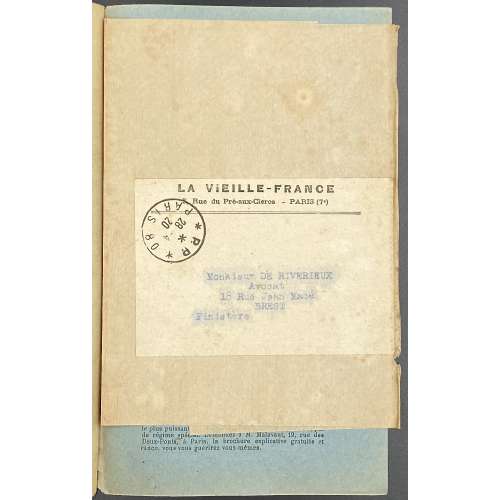 50 issues (full 1920 year) of the French anti-Semitic journal La Vieille France published by Urbain Gohier in Paris from 1916 to 1924. LIB-LIB-2731-1.2021 to LIB-2731-50.2021.
50 issues (full 1920 year) of the French anti-Semitic journal La Vieille France published by Urbain Gohier in Paris from 1916 to 1924. LIB-LIB-2731-1.2021 to LIB-2731-50.2021. -
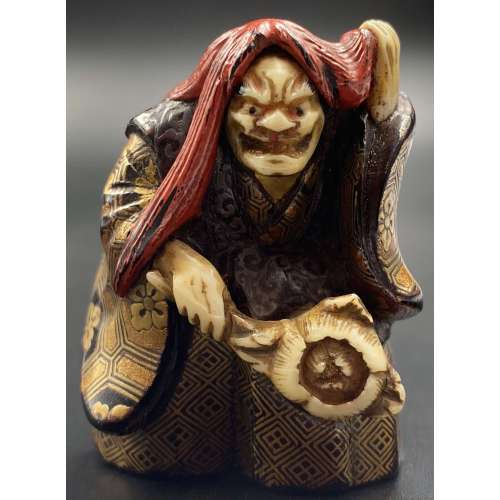 An actor dressed as a witch, with red hair, a gold patterned costume with tortoiseshell and flower lozenge design, and an inlaid ivory mask, hands, feet and flower blossom. Signature to the bottom: Kogyoku [光玉]. Dimensions: 4.17 x 3.07 x 2.99 cm. Provenance: Collection of Gloria and Joe Kurilecz. Sold by Eldred's, on August 25, 1993, Lot #699.
An actor dressed as a witch, with red hair, a gold patterned costume with tortoiseshell and flower lozenge design, and an inlaid ivory mask, hands, feet and flower blossom. Signature to the bottom: Kogyoku [光玉]. Dimensions: 4.17 x 3.07 x 2.99 cm. Provenance: Collection of Gloria and Joe Kurilecz. Sold by Eldred's, on August 25, 1993, Lot #699. -
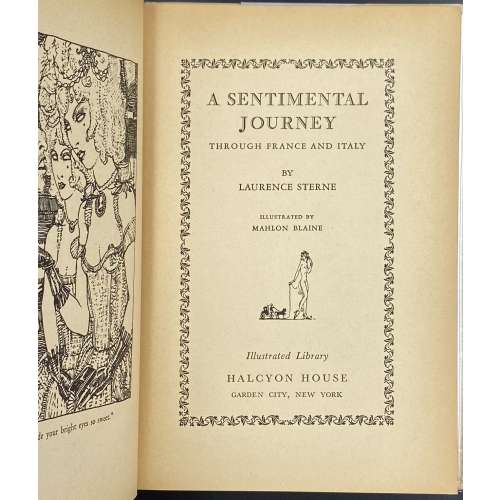 Title: A SENTIMENTAL | JOURNEY | THROUGH FRANCE AND ITALY | BY | LAURENCE STERNE | ILLUSTRATED BY | MAHLON BLAINE | {vignette} | Illustrated library | HALCYON HOUSE | GARDEN CITY, NEW YORK || Pagination: [1-6] – first leaf blank, h.t., t.p., 7-192, total 192 pages; frontispiece plus 4 plates within collation, and a headpiece, all photomechanical reproductions of Mahlon Blaine’s pen drawings. Binding: 20.5 x 14 cm, off-white pictorial paper boards decorated with black ivy-clad pink lattice, black lettering in a pink frame to spine, pink pictorial dust jacket with spine sunned to beige. Contributors: Sterne, Laurence (British-Irish, 1713 – 1768) – author of the text. Blaine, Mahlon (American, 1894 – 1969) – illustrator (pseudonym: G. Christopher Hudson). The Illustrated library series was started by Halcyon House, a reprint division of Doubleday Publishers, in 1950. This edition of Sterne with Blaine’s illustrations is a reprint of the same, published by Three Sirens Press of New York in 1930. Blaine's illustrations of this kind are pen drawings, not wood engravings.
Title: A SENTIMENTAL | JOURNEY | THROUGH FRANCE AND ITALY | BY | LAURENCE STERNE | ILLUSTRATED BY | MAHLON BLAINE | {vignette} | Illustrated library | HALCYON HOUSE | GARDEN CITY, NEW YORK || Pagination: [1-6] – first leaf blank, h.t., t.p., 7-192, total 192 pages; frontispiece plus 4 plates within collation, and a headpiece, all photomechanical reproductions of Mahlon Blaine’s pen drawings. Binding: 20.5 x 14 cm, off-white pictorial paper boards decorated with black ivy-clad pink lattice, black lettering in a pink frame to spine, pink pictorial dust jacket with spine sunned to beige. Contributors: Sterne, Laurence (British-Irish, 1713 – 1768) – author of the text. Blaine, Mahlon (American, 1894 – 1969) – illustrator (pseudonym: G. Christopher Hudson). The Illustrated library series was started by Halcyon House, a reprint division of Doubleday Publishers, in 1950. This edition of Sterne with Blaine’s illustrations is a reprint of the same, published by Three Sirens Press of New York in 1930. Blaine's illustrations of this kind are pen drawings, not wood engravings. -
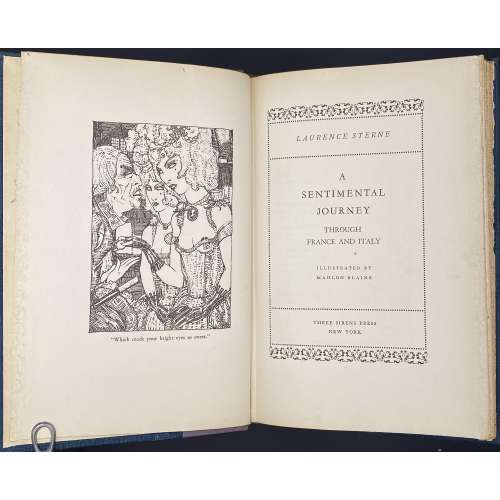 Title page (frame, three compartments: LAURENCE STERNE |—| A | SENTIMENTAL | JOURNEY | THROUGH | FRANCE AND ITALY | ILLUSTRATED BY | MAHLON BLAINE |—| THREE SIRENS PRESS | NEW YORK || Title verso: (top) COPYRIGHT, 1930, BY WILLIAMS, BELASCO & MEYERS | PRINTED IN THE UNITED STATES OF AMERICA | (bottom) BY J. J. LITTLE & IVES COMPANY, NEW YORK || Pagination: [1-6] 7-192, frontispiece, headpiece, and 4 plates within collation (pp. 45, 85, 141, and 185) after Blaine’s pen drawings in the woodcut manner. Binding: quarter lilac morocco with stamped brown lettering over blue cloth, design elements and lettering to spine, top edge gilt, fore-edge untrimmed. Size: 24.5 x 16 cm Edition: presumably 1st edition with plates after Blaine. Contributors: Sterne, Laurence (British-Irish, 1713 – 1768) – author of the text. Blaine, Mahlon (American, 1894 – 1969) – illustrator (pseudonym: G. Christopher Hudson). Three Sirens Press (NY); Williams, Belasco, and Meyers (NY) – publishers. J. J. Little & Ives Company (NY) – printer. Compare to the re-printed edition by Halcyon House, [c. 1950] in the collection [LIB-2783.2021].
Title page (frame, three compartments: LAURENCE STERNE |—| A | SENTIMENTAL | JOURNEY | THROUGH | FRANCE AND ITALY | ILLUSTRATED BY | MAHLON BLAINE |—| THREE SIRENS PRESS | NEW YORK || Title verso: (top) COPYRIGHT, 1930, BY WILLIAMS, BELASCO & MEYERS | PRINTED IN THE UNITED STATES OF AMERICA | (bottom) BY J. J. LITTLE & IVES COMPANY, NEW YORK || Pagination: [1-6] 7-192, frontispiece, headpiece, and 4 plates within collation (pp. 45, 85, 141, and 185) after Blaine’s pen drawings in the woodcut manner. Binding: quarter lilac morocco with stamped brown lettering over blue cloth, design elements and lettering to spine, top edge gilt, fore-edge untrimmed. Size: 24.5 x 16 cm Edition: presumably 1st edition with plates after Blaine. Contributors: Sterne, Laurence (British-Irish, 1713 – 1768) – author of the text. Blaine, Mahlon (American, 1894 – 1969) – illustrator (pseudonym: G. Christopher Hudson). Three Sirens Press (NY); Williams, Belasco, and Meyers (NY) – publishers. J. J. Little & Ives Company (NY) – printer. Compare to the re-printed edition by Halcyon House, [c. 1950] in the collection [LIB-2783.2021].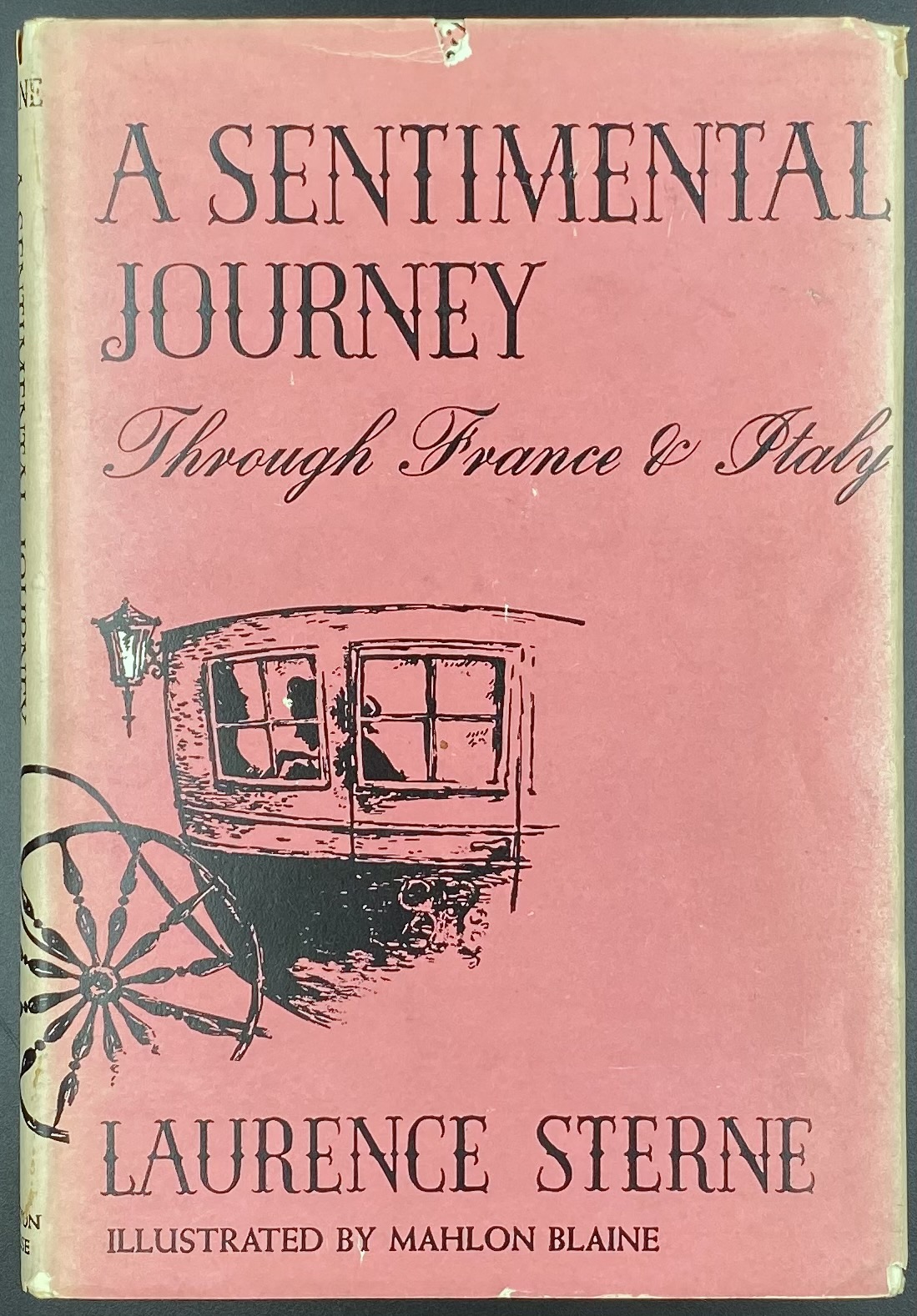 As stated, the copyright is held by Williams, Belasco, and Meyers, who are: Joseph Meyers (c. 1898 – 1957), his sister Edna Williams, and David Belasco (1853 – 1931). "Joseph Meyers was described by Bennet Cerf (Modern Library, Random House) as a “notorious pirate” in Gertzman’s book Bookleggers and Smuthounds, and the trio of presses allegedly indulged in reprinting numerous books without holding the copyright to those titles. By not paying copyright fees, Meyers and Williams were able to print and sell good quality illustrated books at prices that were below typical smaller, unillustrated reprint series of the 1930s." [cit.]
As stated, the copyright is held by Williams, Belasco, and Meyers, who are: Joseph Meyers (c. 1898 – 1957), his sister Edna Williams, and David Belasco (1853 – 1931). "Joseph Meyers was described by Bennet Cerf (Modern Library, Random House) as a “notorious pirate” in Gertzman’s book Bookleggers and Smuthounds, and the trio of presses allegedly indulged in reprinting numerous books without holding the copyright to those titles. By not paying copyright fees, Meyers and Williams were able to print and sell good quality illustrated books at prices that were below typical smaller, unillustrated reprint series of the 1930s." [cit.]
-
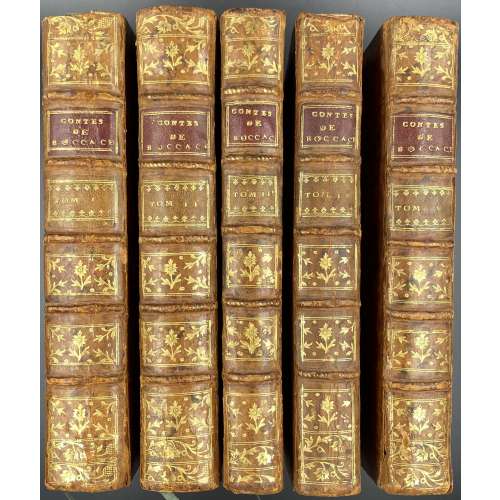 Five volumes, uniformly bound in marbled three-colour stained polished calf, spine with raised bands, gilt in compartments, crimson label with gilt lettering “CONTES DE BOCCACE”, cream label with volume number, marbled endpapers and all edges; bookplate pasted to first blank flyleaf “BIBLIOTHÈQUE DE LAJUDIE” depicting a coat of arms over an anchor, anchors and tulips scattered in the upper section, globe in the lower section, in a frame. Size: 21 x 14 cm. Translated by Antoine Le Maçon (French, 1500? – 1559). Vol. 1: [4] two blank leaves, portrait by Louis Lempereur after Hubert Gravelot, engraved t.p.: LE | DECAMERON | DE JEAN | BOCCACE. | TOME I. | Londres | 1757. | H. Gravelot Inv. […] T.P. N 21 […] J. Aliamet Sculp. ||, engraved frontispiece to Vie de Jean Bocace by Lempereur after Gravelot; Pagination: [i] ii-viii (Vie de Jean Bocace with head- and tail-pieces); [1] 2-320 [2] one blank leaf. Collation: 8vo; a4 A-V8, 164 leaves + 6 blanks + 24 plates (incl. portrait, frontis., and t.p.) extraneous to collation, 1 headpiece and 18 tailpieces. Vol. 2: [4] two blank leaves, engraved t.p.: LE | DECAMERON | DE JEAN | BOCCACE. | TOME II. | Londres 1757 | H. Gravelot inv. […] T.II. N.1. […] N. LeMire Sculp .||; Pagination: [1] 2-292 [2] one blank leaf. Collation: 8vo; A-S8 T2, 146 leaves + 3 blanks + 23 plates (incl. t.p.) extraneous to collation, and 18 tailpieces. Vol. 3: [4] two blank leaves, engraved t.p.: LE | DECAMERON | DE JEAN | BOCCACE. | TOME III. | Londres 1757 | Gravelot inv. […] T.III. N.1. […] Aillamet Sc. ||; Pagination: [1] 2-203 [204] [2] one blank leaf. Collation: 8vo; A-M8 N6, 102 leaves + 3 blanks + 23 plates (incl. t.p.) extraneous to collation, and 18 tailpieces. Vol. 4: [4] two blank leaves, engraved t.p.: LE | DECAMERON | DE JEAN | BOCCACE. | TOME IV. | Lond 1761 | Gravelot invenit […] T.IV. №.I. […] Alliamet Sculpsit. ||; Pagination: [1] 2-280 [2] one blank leaf. Collation: 8vo; A-R8 S4, 140 leaves + 3 blanks + 23 plates (incl. t.p.) extraneous to collation, and 20 tailpieces. Vol. 5: [4] two blank leaves, engraved t.p.: LE | DECAMERON | DE JEAN | BOCCACE. | TOME V. | Londres 1761 | Gravelot, inv. […] T.V. N.1. […] Aillamet Sc. ||; Pagination: [1] 2 [3] 4-269 [270] [2] one blank leaf. Collation: 8vo; A-Q8 R7, 135 leaves + 3 blanks + 23 plates (incl. t.p.) extraneous to collation, and 22 tailpieces. Total plates: 24+23+23+23+23=112; total vignettes: 19+ 18 + 18 +20 + 22 = 94; total etchings and engravings: 213. Ref: MFA ACCESSION NUMBER 37.1371a-e; Cohen-de Ricci 160; Ray, French Illustrated Book, 15 / p. 39-41; Metropolitan Museum, NY (Accession Number: 17.3.2641). Contributors: Authors: Giovanni Boccaccio (Italian, 1313–1375); Filippo Villani [Philippe-Matthieu Villani] (Italian, 1325 – 1407)Illustrated by: Hubert François Gravelot (French, 1699–1773). Artists: Charles Eisen (French, 1720–1778); François Boucher (French, 1703–1770); Charles-Nicolas Cochin le fils (French, 1715–1790), Jacques Aliamet (French, 1726–1788) Engravers: Jean Charles Baquoy (French, 1721–1777); Jean Jacques Flipart (French, 1719–1782); Louis Legrand (French, 1723–1807); Noël Le Mire (French, 1724–1801); Louis Simon Lempereur (French, 1725–1796); Catherine Elisabeth (Cousinet) Lempereur (French, born in 1726); Jean-Jacques André Le Veau (French, 1729–1786); Pierre Etienne Moitte (French, 1722–1780); Jean Ouvrier (French, 1725–1784); Jean Jacques Pasquier (French, died in 1785); Pierre (Pitre) Martenasie (Flemish, worked in France, died in 1770?); Augustin de Saint-Aubin (French, 1736–1807); Dominique Sornique (French, 1708 – 1756); Jacques Nicolas Tardieu (French, 1716–1791). Publisher: Prault (French, 18th century) Note: MFA copy has a slightly different collation: [v. 1] 152 leaves, plus plates; [v. 2] 136 ll., plus pls.; [v. 3] 98 ll., plus pls.; [v. 4] 131 ll., plus pls.; [v. 5] 124 ll., plus pls. This is their description: "First edition with these illustrations; a French translation (Cohen-de Ricci 160) appeared slightly later. Gravelot designed 89 of the 111 plates, and all 97 of the tailpieces, his largest single commission. Some 115 of his preliminary sketches by this series are in the Rosenwald Collection, Library of Congress; 131 of the final engraver's models are in the Widener Collection at the National Gallery of Art; and two other finished drawings are in the Ray Collection, Pierpont Morgan Library. Ten plates were designed by Eisen, and Cochin and Boucher had six each. As some plates in the later volumes are dated as late as 1761, the actual issuing of the volumes apparently extended to that date."
Five volumes, uniformly bound in marbled three-colour stained polished calf, spine with raised bands, gilt in compartments, crimson label with gilt lettering “CONTES DE BOCCACE”, cream label with volume number, marbled endpapers and all edges; bookplate pasted to first blank flyleaf “BIBLIOTHÈQUE DE LAJUDIE” depicting a coat of arms over an anchor, anchors and tulips scattered in the upper section, globe in the lower section, in a frame. Size: 21 x 14 cm. Translated by Antoine Le Maçon (French, 1500? – 1559). Vol. 1: [4] two blank leaves, portrait by Louis Lempereur after Hubert Gravelot, engraved t.p.: LE | DECAMERON | DE JEAN | BOCCACE. | TOME I. | Londres | 1757. | H. Gravelot Inv. […] T.P. N 21 […] J. Aliamet Sculp. ||, engraved frontispiece to Vie de Jean Bocace by Lempereur after Gravelot; Pagination: [i] ii-viii (Vie de Jean Bocace with head- and tail-pieces); [1] 2-320 [2] one blank leaf. Collation: 8vo; a4 A-V8, 164 leaves + 6 blanks + 24 plates (incl. portrait, frontis., and t.p.) extraneous to collation, 1 headpiece and 18 tailpieces. Vol. 2: [4] two blank leaves, engraved t.p.: LE | DECAMERON | DE JEAN | BOCCACE. | TOME II. | Londres 1757 | H. Gravelot inv. […] T.II. N.1. […] N. LeMire Sculp .||; Pagination: [1] 2-292 [2] one blank leaf. Collation: 8vo; A-S8 T2, 146 leaves + 3 blanks + 23 plates (incl. t.p.) extraneous to collation, and 18 tailpieces. Vol. 3: [4] two blank leaves, engraved t.p.: LE | DECAMERON | DE JEAN | BOCCACE. | TOME III. | Londres 1757 | Gravelot inv. […] T.III. N.1. […] Aillamet Sc. ||; Pagination: [1] 2-203 [204] [2] one blank leaf. Collation: 8vo; A-M8 N6, 102 leaves + 3 blanks + 23 plates (incl. t.p.) extraneous to collation, and 18 tailpieces. Vol. 4: [4] two blank leaves, engraved t.p.: LE | DECAMERON | DE JEAN | BOCCACE. | TOME IV. | Lond 1761 | Gravelot invenit […] T.IV. №.I. […] Alliamet Sculpsit. ||; Pagination: [1] 2-280 [2] one blank leaf. Collation: 8vo; A-R8 S4, 140 leaves + 3 blanks + 23 plates (incl. t.p.) extraneous to collation, and 20 tailpieces. Vol. 5: [4] two blank leaves, engraved t.p.: LE | DECAMERON | DE JEAN | BOCCACE. | TOME V. | Londres 1761 | Gravelot, inv. […] T.V. N.1. […] Aillamet Sc. ||; Pagination: [1] 2 [3] 4-269 [270] [2] one blank leaf. Collation: 8vo; A-Q8 R7, 135 leaves + 3 blanks + 23 plates (incl. t.p.) extraneous to collation, and 22 tailpieces. Total plates: 24+23+23+23+23=112; total vignettes: 19+ 18 + 18 +20 + 22 = 94; total etchings and engravings: 213. Ref: MFA ACCESSION NUMBER 37.1371a-e; Cohen-de Ricci 160; Ray, French Illustrated Book, 15 / p. 39-41; Metropolitan Museum, NY (Accession Number: 17.3.2641). Contributors: Authors: Giovanni Boccaccio (Italian, 1313–1375); Filippo Villani [Philippe-Matthieu Villani] (Italian, 1325 – 1407)Illustrated by: Hubert François Gravelot (French, 1699–1773). Artists: Charles Eisen (French, 1720–1778); François Boucher (French, 1703–1770); Charles-Nicolas Cochin le fils (French, 1715–1790), Jacques Aliamet (French, 1726–1788) Engravers: Jean Charles Baquoy (French, 1721–1777); Jean Jacques Flipart (French, 1719–1782); Louis Legrand (French, 1723–1807); Noël Le Mire (French, 1724–1801); Louis Simon Lempereur (French, 1725–1796); Catherine Elisabeth (Cousinet) Lempereur (French, born in 1726); Jean-Jacques André Le Veau (French, 1729–1786); Pierre Etienne Moitte (French, 1722–1780); Jean Ouvrier (French, 1725–1784); Jean Jacques Pasquier (French, died in 1785); Pierre (Pitre) Martenasie (Flemish, worked in France, died in 1770?); Augustin de Saint-Aubin (French, 1736–1807); Dominique Sornique (French, 1708 – 1756); Jacques Nicolas Tardieu (French, 1716–1791). Publisher: Prault (French, 18th century) Note: MFA copy has a slightly different collation: [v. 1] 152 leaves, plus plates; [v. 2] 136 ll., plus pls.; [v. 3] 98 ll., plus pls.; [v. 4] 131 ll., plus pls.; [v. 5] 124 ll., plus pls. This is their description: "First edition with these illustrations; a French translation (Cohen-de Ricci 160) appeared slightly later. Gravelot designed 89 of the 111 plates, and all 97 of the tailpieces, his largest single commission. Some 115 of his preliminary sketches by this series are in the Rosenwald Collection, Library of Congress; 131 of the final engraver's models are in the Widener Collection at the National Gallery of Art; and two other finished drawings are in the Ray Collection, Pierpont Morgan Library. Ten plates were designed by Eisen, and Cochin and Boucher had six each. As some plates in the later volumes are dated as late as 1761, the actual issuing of the volumes apparently extended to that date." -
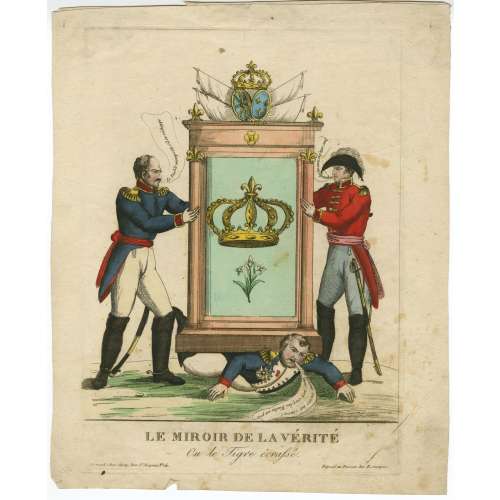 Hand-coloured etching by an anonymous artist, printed in July 1815. Description by British Museum (1866,0407.935): "Blücher (left) and Napoleon (right) support a heavy pier-glass in an upright position. Its solid base rests on the back of the prostrate Napoleon, from whose mouth issues a label: 'Si je pouvais encore me sauver! . . . mais non c'est fini Nicolas est pris.' The mirror, which towers above the head of its supporters, is framed by pillars, each surmounted by a fleur-de-lis. These also decorate the heavy superstructure which supports a trophy of two oval shields with the arms of Bourbon and Navarre, surmounted by a crown..., and four white flags. On the face of the mirror is a large Bourbon crown, and a lily plant. Blücher says: "Le Diable m'emporte s'il en réchappe." Wellington responds: "Pour cette fois nous en répondons." Inscription under the plate: 'Se vend chez Genty, rue St Jacques no.14' and 'Déposé au Bureau des Estampes'. Size: 33.2 x 25.7 cm
Hand-coloured etching by an anonymous artist, printed in July 1815. Description by British Museum (1866,0407.935): "Blücher (left) and Napoleon (right) support a heavy pier-glass in an upright position. Its solid base rests on the back of the prostrate Napoleon, from whose mouth issues a label: 'Si je pouvais encore me sauver! . . . mais non c'est fini Nicolas est pris.' The mirror, which towers above the head of its supporters, is framed by pillars, each surmounted by a fleur-de-lis. These also decorate the heavy superstructure which supports a trophy of two oval shields with the arms of Bourbon and Navarre, surmounted by a crown..., and four white flags. On the face of the mirror is a large Bourbon crown, and a lily plant. Blücher says: "Le Diable m'emporte s'il en réchappe." Wellington responds: "Pour cette fois nous en répondons." Inscription under the plate: 'Se vend chez Genty, rue St Jacques no.14' and 'Déposé au Bureau des Estampes'. Size: 33.2 x 25.7 cm


